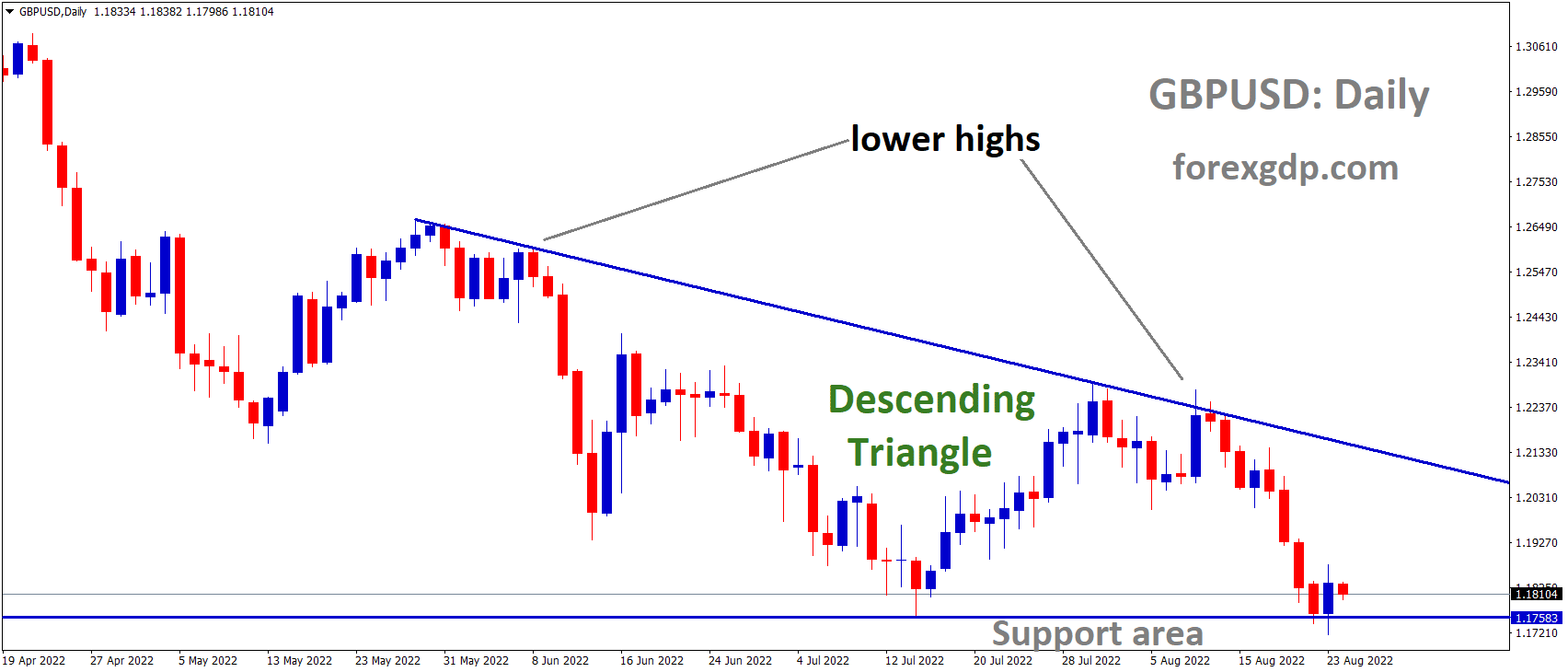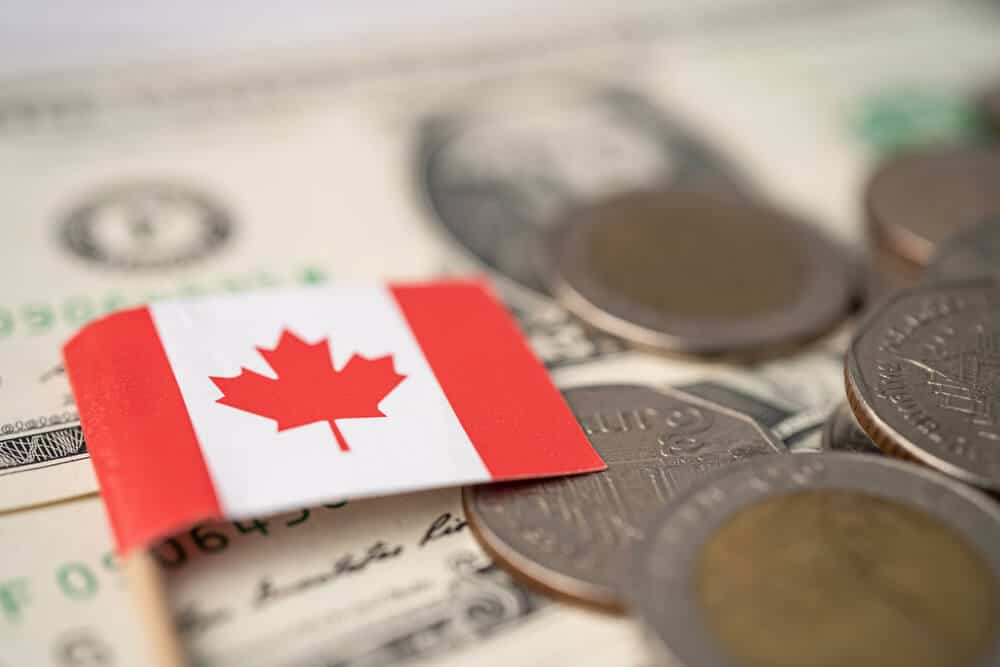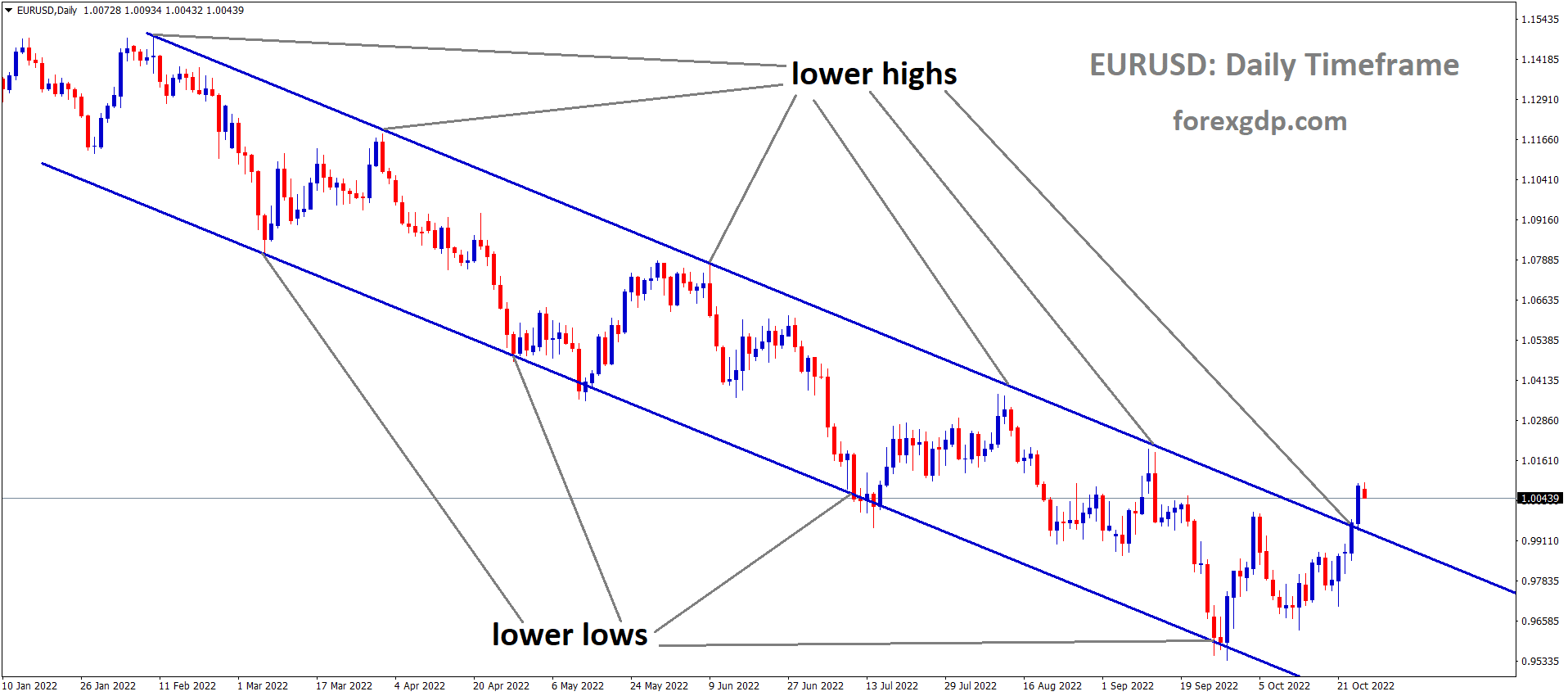XAUUSD Faces Pressure with Market Cheer and Solid US Indicators
Gold has long been a favorite safe-haven asset. When the global economy feels uncertain, people often turn to it as a store of value. But lately, that shine has dulled a bit. A mix of stronger economic data from the U.S., optimism surrounding international trade developments, and a resurgent U.S. Dollar have pushed gold prices lower. Let’s break down why gold’s taking a breather and what’s happening behind the scenes.
Why Gold Is Losing Some Luster Right Now
When you look at what’s happening in the markets, it’s clear that a few major forces are dragging gold prices down. It’s not just about gold itself, but about the broader economic picture and how investors are reacting to it.
Strong U.S. Jobs Market Keeps Confidence High
Recently, the U.S. labor market has been flexing its muscles. Weekly reports showed that fewer people are filing for unemployment benefits, indicating that the job market remains strong. For four straight weeks, the number of jobless claims has dropped.
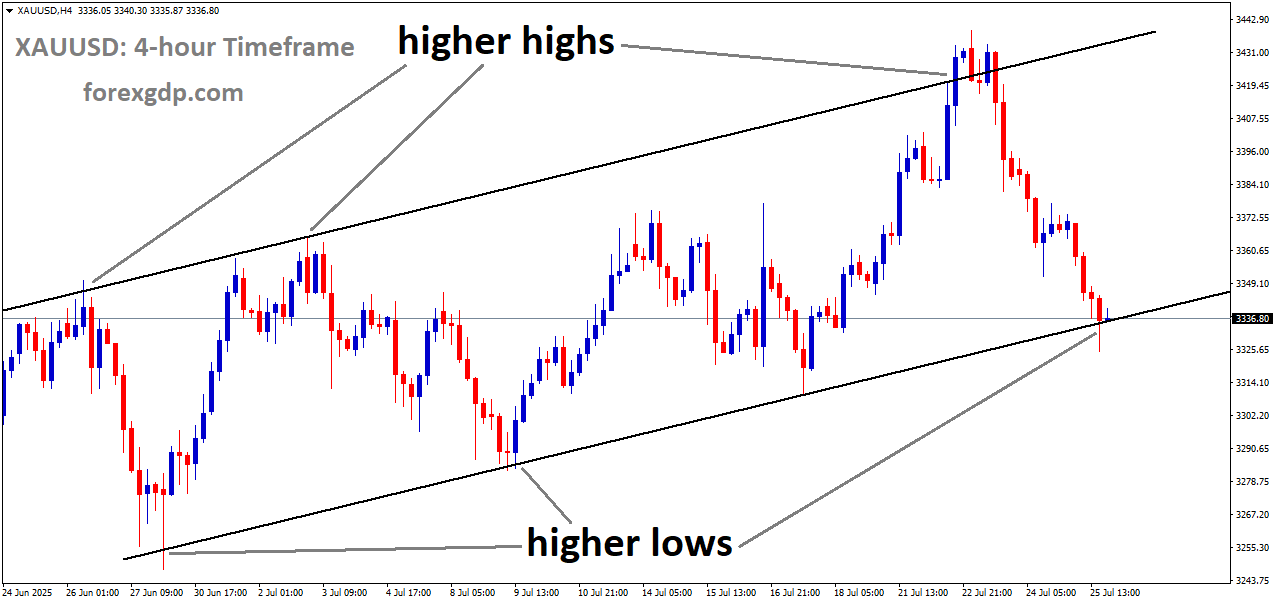
XAUUSD is moving in an Ascending channel, and the market has reached the higher low area of the channel
That kind of steady employment picture makes investors feel good about the economy. And when people feel confident, they move their money into assets that offer returns—like stocks or interest-bearing investments—instead of safe-haven assets like gold.
U.S. Economic Reports Add Fuel to the Fire
Beyond jobs, there’s also been other data pointing to resilience in the American economy. For instance, core durable goods orders, which exclude big-ticket transportation items like airplanes, actually increased slightly. That’s a good sign that businesses are still investing.
Even though overall durable goods orders fell due to fewer aircraft purchases, that kind of drop is expected from time to time and doesn’t necessarily signal weakness across the board. Meanwhile, inflation-adjusted yields (what you get after accounting for inflation) are holding firm. All of this suggests the economy isn’t slowing down dramatically—which takes the pressure off the Fed to cut interest rates.
Trade Developments Spark More Optimism
International trade is another area where things are looking up, and that’s bad news for gold.
U.S. and Japan Lay the Groundwork
Earlier in the week, the U.S. and Japan reached an agreement on a trade deal. It’s not a massive one, but it’s enough to show that progress is being made. Investors love when there’s clarity in trade relationships because it reduces the chance of economic disruptions.
Hopes Rising for a U.S.-EU Deal
There’s also buzz that the U.S. and European Union might finalize a trade agreement before a key deadline. If that happens, it’ll reduce trade tensions even more. Again, this kind of news makes investors more comfortable taking risks—which means they’re less likely to buy gold as a form of protection.

President Trump added to the excitement by announcing that many trade deals are nearly complete. While he mentioned that there’s still only a “50-50” chance of a deal with the EU, markets often react just to the possibility. And this optimism alone was enough to push gold lower this week.
The Role of the U.S. Dollar in Gold’s Drop
If you’re wondering why the U.S. Dollar matters here, the answer is pretty simple: gold is priced in dollars. When the dollar gets stronger, it takes more of other currencies to buy the same amount of gold. That makes gold more expensive for international buyers—and demand usually dips as a result.
Over the past few days, the dollar has been making a comeback. After dipping to nearly a two-week low, it bounced back strongly. That rebound, paired with expectations that the Fed isn’t in a rush to lower interest rates, has taken some wind out of gold’s sails.
The U.S. Dollar Index, which tracks the dollar against a basket of major world currencies, has ticked upward. And while that move isn’t huge, it’s enough to make gold a little less attractive to global investors.
What’s Coming Up Next Week: Big Decisions Ahead
If you think the market’s been busy this week, next week might be even more interesting. There’s a bunch of high-impact events lined up that could set the tone for where gold goes next.
Federal Reserve’s Rate Decision
All eyes are on the Fed as it prepares for its upcoming meeting. Most experts believe the central bank will hold interest rates steady. In fact, there’s a 96% chance they’ll keep rates right where they are.
Why does this matter? Because interest rates and gold often move in opposite directions. When rates are high, assets like bonds become more attractive, which can pull investors away from gold. But if the Fed signals that a rate cut might happen soon, gold could get a bit of a boost.
Key Economic Reports to Watch
On top of the Fed meeting, we’ve also got:
-
U.S. GDP Figures for Q2 – This will give us a clearer picture of how fast the economy grew last quarter.
-
Core PCE (Personal Consumption Expenditures) – This is the Fed’s favorite measure of inflation. A higher reading could mean inflation is still sticky, which might delay any potential rate cuts.
-
Nonfarm Payrolls (NFP) – This crucial jobs report can shift market sentiment fast. If hiring remains strong, it reinforces the idea that the economy is still chugging along.
All of these releases have the potential to influence how people feel about risk, inflation, and the broader economic outlook—and that directly affects gold.
Quick Take: What This All Means for Gold Buyers and Investors
If you’re thinking about getting into gold right now, it’s worth keeping these things in mind:
-
The economy is showing strength, especially in the U.S., which reduces the appeal of safe-haven assets like gold.
-
Trade optimism is on the rise, lowering global economic fears.
-
The U.S. Dollar is gaining ground, which puts pressure on gold prices from a currency standpoint.
-
Next week’s events could swing things either way, depending on how the data comes in and how the Fed responds.
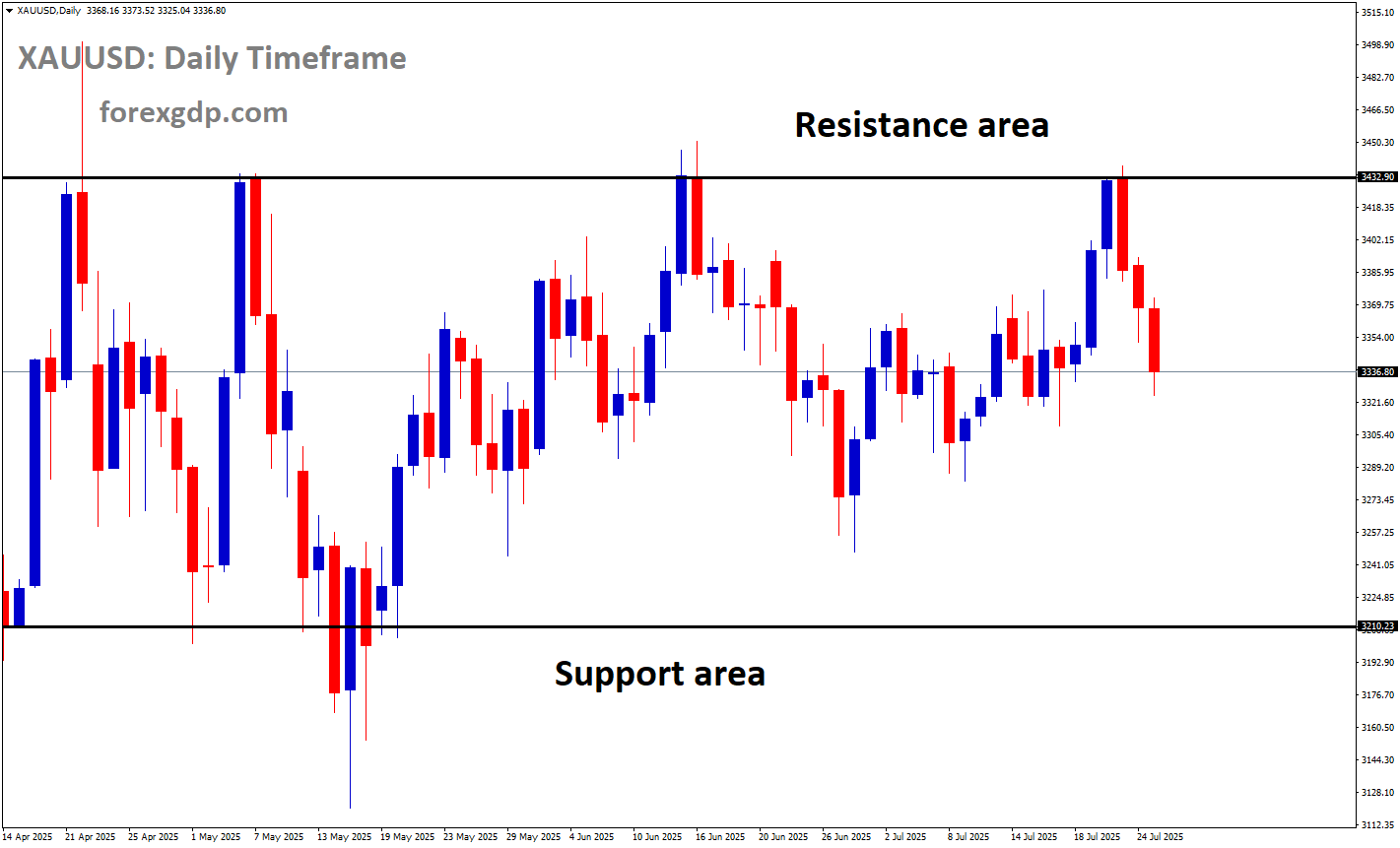
XAUUSD is moving in a box pattern
Final Summary
Gold is in a bit of a holding pattern right now, caught between strong U.S. economic data, positive trade headlines, and a rising dollar. The traditional reasons for buying gold—fear, uncertainty, and a weak dollar—just aren’t as strong at the moment.
But things can change quickly in the world of finance. With several big economic reports and a crucial Fed decision around the corner, we could see a shift in sentiment. If inflation ticks up or job numbers disappoint, gold might find its footing again.
For now, though, the yellow metal seems to be on the defensive, and investors are watching closely to see what the next chapter holds.
EURUSD Surges with Fresh Trade Optimism, Shrugs Off Weak Economic Data
It’s been an exciting ride for EUR/USD watchers this week. While the pair ended the week with a strong performance, gaining nearly 1%, the daily momentum on Friday seemed to cool off, holding steady after some key developments in the US and Europe. What really gave traders something to talk about was a combination of shifting economic data and some hopeful signs on the trade front between the US and EU.
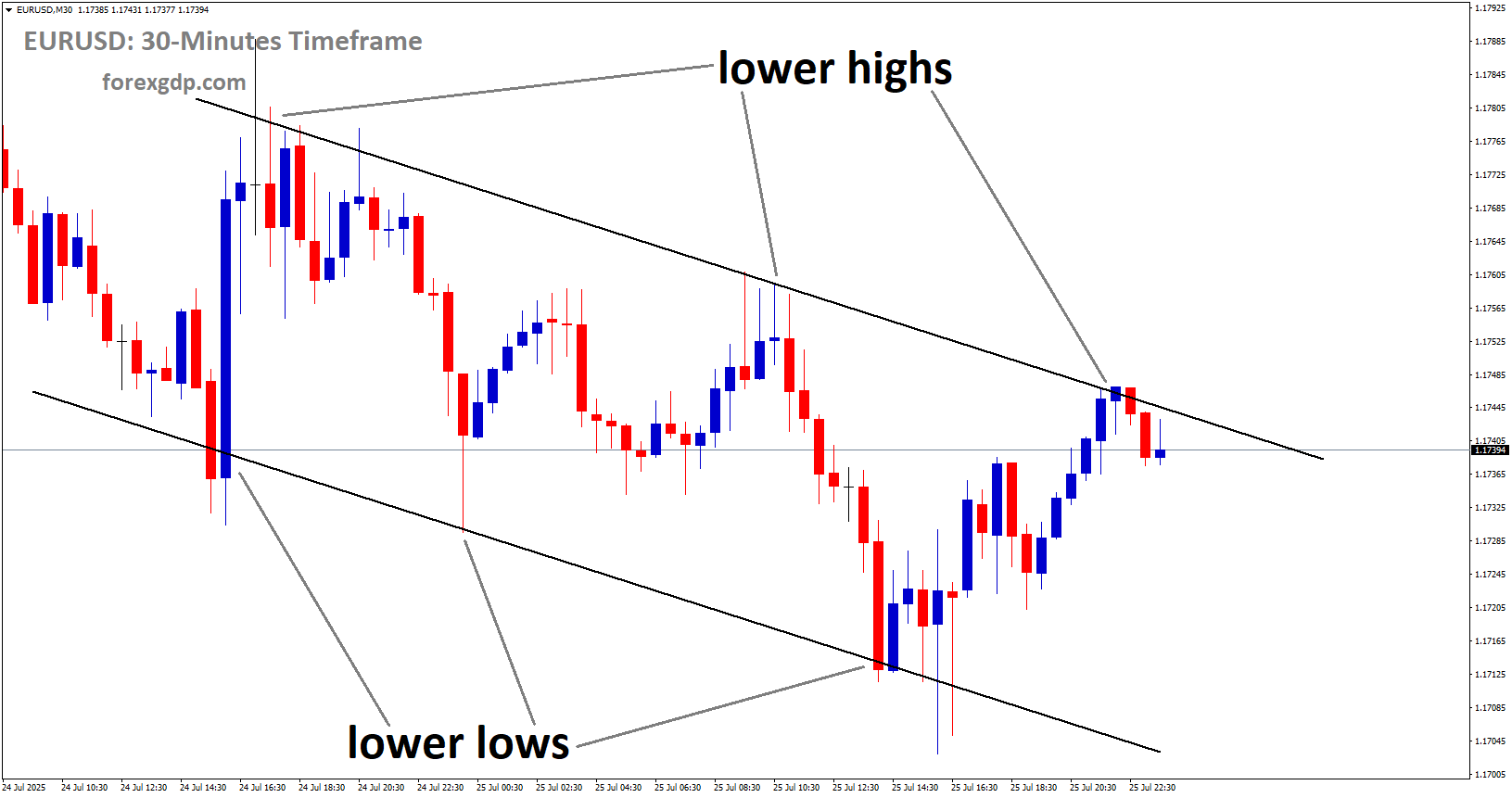
EURUSD is moving in a descending channel, and the market has reached the lower high area of the channel
Let’s dig into what made this week so significant, and why everyone’s now looking ahead to what the US Federal Reserve has to say next.
Strong Job Numbers Meet Weak Factory Orders: A Tale of Two US Economies
This week brought a mixed bag from the United States. The numbers on factory orders — more formally known as Durable Goods Orders — didn’t live up to expectations. After a big jump the month before, the latest figures showed a noticeable drop, largely due to falling demand in the transportation sector, especially aircraft.
But just as people were starting to get concerned, the labor market came to the rescue. Jobless claims were better than expected, showing that employers are still hiring, and that the job market is holding strong. For traders and investors, this sent a clear message: the US economy isn’t slowing down as much as some feared, and that may give the Federal Reserve more confidence to hold interest rates where they are for now.
So even though manufacturing looks a little shaky, the job numbers helped steady the ship — at least for the time being.
US–EU Trade Talks: A Breath of Fresh Air for the Euro
The real buzz this week came from whispers about a possible breakthrough in US–EU trade talks. Traders were quick to react when news broke that the US and the European Union might be on the verge of finalizing a trade agreement — and all before the looming August 1 deadline.
This would be a big deal. Not just for the EUR/USD pair, but for global trade sentiment in general. A deal between two of the world’s largest economies would ease tensions that have lingered for years, and could open up new opportunities for both sides.
Earlier in the week, positive news about a trade deal with Japan had already nudged EUR/USD higher. Then came the bombshell from the Financial Times, reporting that talks between the US and EU were going well and a deal might be ready just in time. That helped support the Euro and encouraged more buying from optimistic investors.
While the actual outcome of the talks is still uncertain — with some suggesting the chances are 50-50 — just the possibility of progress has lifted spirits. Markets love clarity, and this week delivered just enough of it to keep momentum going in the Euro’s favor.

Europe Plays It Cool: ECB Holds Rates While Watching the Data
On the European side, the European Central Bank (ECB) didn’t make any bold moves this week. As widely expected, the ECB left interest rates unchanged. What’s more interesting, though, is how they’re choosing to navigate the next few months.
Rather than committing to any future rate hikes or cuts, the ECB has made it clear that they’ll take things one meeting at a time. This “wait and see” approach is understandable given the mixed signals from the European economy.
The central bank noted that most recent data is in line with what they expected, but they also acknowledged that there’s still a lot of uncertainty ahead. With inflation cooling in some parts of the EU, and other regions still facing challenges, the ECB’s cautious stance didn’t come as a surprise to anyone.
For now, traders seem comfortable with the ECB’s approach — especially with bigger events on the horizon from across the Atlantic.
What’s Coming Next? The Fed Takes the Spotlight
If this week was about hints and rumors, next week is all about the main event — the upcoming Federal Reserve meeting. The market is almost certain that the Fed will keep interest rates steady, with over a 98% chance priced in by analysts.
But what everyone will be listening for is the Fed’s tone. Are they feeling more confident about the economy? Are they still worried about inflation? Do they see any reason to adjust their path in the months ahead?
All of these questions could shape how EUR/USD performs in the near future. A more cautious Fed could weigh on the US Dollar and help the Euro climb even higher. On the flip side, if the Fed sounds upbeat and hints that rates might stay elevated for longer, the Dollar could regain its strength and cap any Euro rally.
So all eyes are on July 30, when the Fed delivers its verdict. And with a packed schedule next week — including US GDP numbers, inflation readings, and employment data — there’s plenty of fuel to keep markets moving.
The Bigger Picture: Why This Matters for EUR/USD Traders
Here’s the deal: this week wasn’t just about numbers. It was about shifting momentum, rising hope for trade deals, and the calm before a potentially stormy week ahead.
Even though the ECB stayed quiet and US data painted a mixed picture, the broader tone is now more optimistic. The possibility of a US–EU trade deal added a spark that helped EUR/USD push higher. At the same time, strong job data helped steady nerves in the US, despite weakness in manufacturing.
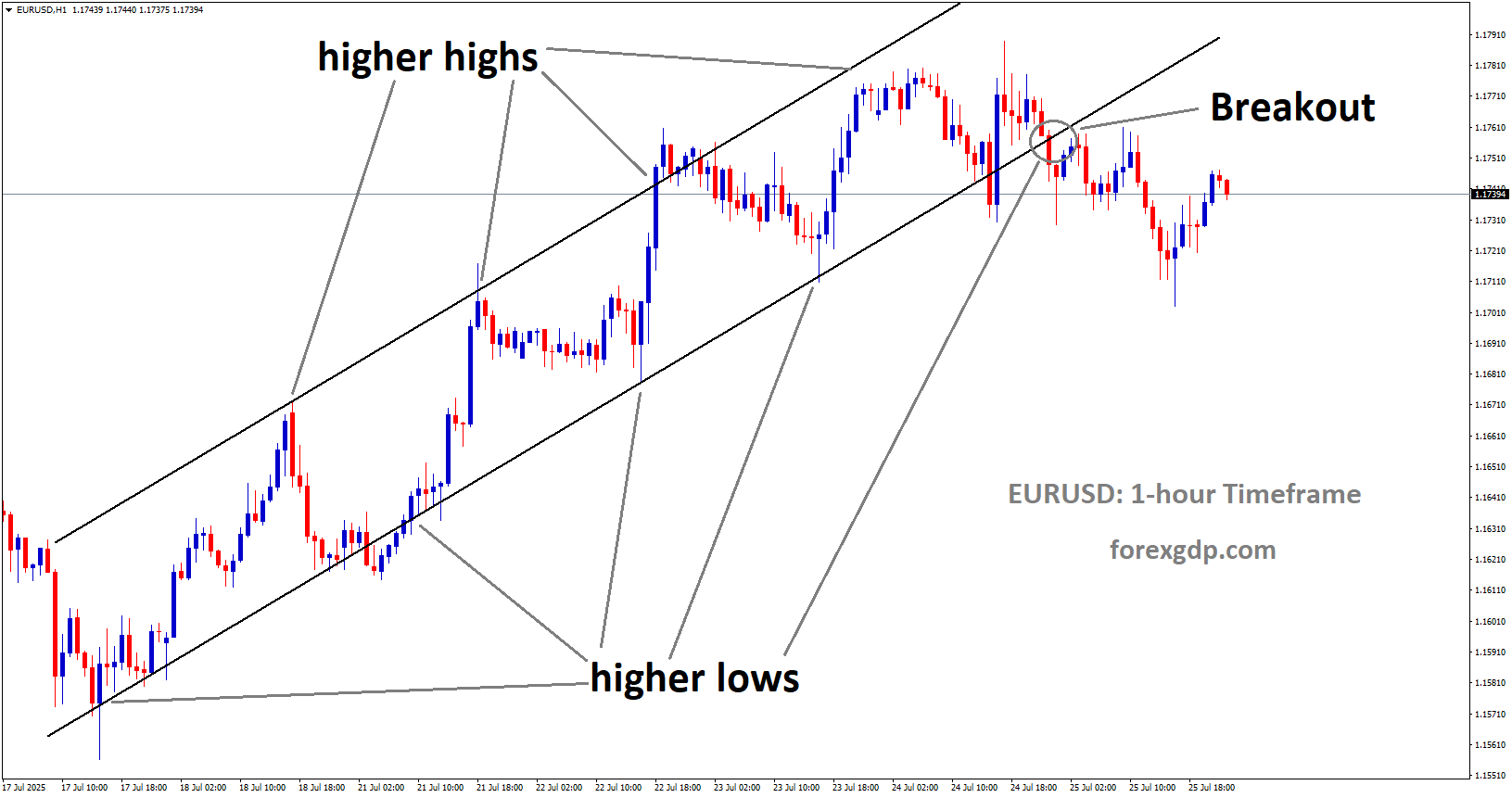
EURUSD has broken the Ascending channel on the downside
What we’re seeing is a pair that’s consolidating — not breaking out, not breaking down — but finding its footing as traders wait for bigger clues.
Final Summary: A Calm Before the Fed Storm
This week showed how even small pieces of news — like a slight dip in factory orders or a hopeful quote from a trade negotiation — can shift the mood in major currency markets. EUR/USD held steady, buoyed by encouraging developments on both sides of the Atlantic.
But now, attention turns to what’s next. With the Federal Reserve set to speak soon and important economic figures on the calendar, we’re heading into a week that could bring a whole new wave of action.
Whether you’re trading, watching, or just curious — stay tuned. This story isn’t over yet.
GBPUSD Slips as UK Shoppers Hold Back and US Job Market Shines
The U.S. job market just reminded everyone that it’s still going strong, even as the Federal Reserve holds its position. The latest jobless claims report came in better than most experts predicted, which usually means fewer people are filing for unemployment benefits — a strong sign that businesses are holding on to their workers.
What does this tell us? It reinforces the idea that the U.S. economy isn’t slowing down as much as some feared. When jobless claims fall below expectations, it shows that employers are still confident. They’re not laying people off in droves, which often happens when a recession is looming. That kind of news usually strengthens the dollar and boosts investor confidence.
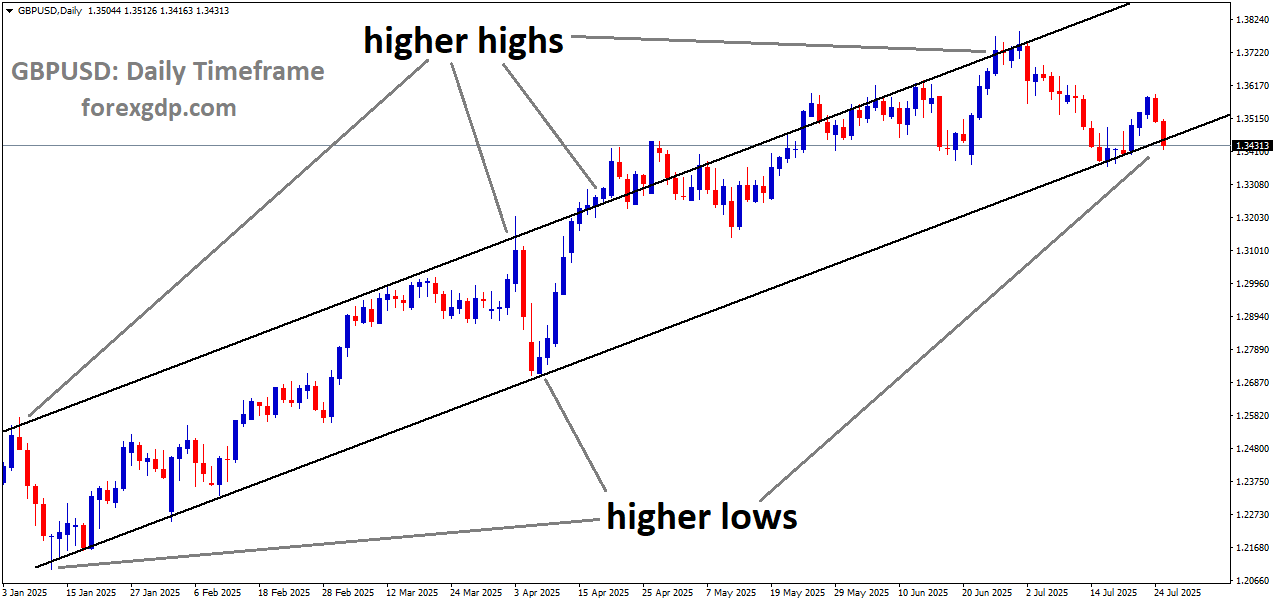
GBPUSD is moving in an uptrend channel, and the market has reached the higher low area of the channel
Now, it wasn’t all perfect. Some reports, like the one from S&P Global, noted that U.S. manufacturing activity did take a hit. But investors seemed more focused on the job numbers, viewing them as a clear sign that the Fed doesn’t need to rush into any major changes for now. Stability in job data gives policymakers room to breathe.
Durable Goods Data Paints a Mixed Picture – But It’s Not All Bad
Durable Goods Orders can be tricky to interpret. These are the orders placed for big-ticket items like appliances, vehicles, and machinery — things that last a while. When this number drops significantly, it might hint at economic weakness because businesses and consumers aren’t spending on big investments.
In June, overall Durable Goods Orders did drop quite a bit. That headline number made a few people nervous. But here’s where things get interesting: the drop was mostly due to a sharp decrease in aircraft orders, which are known to be volatile. If you strip out transportation (which includes those aircraft orders), the story changes.
Core Durable Goods Orders, which exclude the more unpredictable transportation data, actually went up slightly. That means demand for other equipment — like machinery and computers — is still ticking along. So, while the headline number looked scary, the core data signaled underlying strength. It’s a reminder to look deeper before reacting.
What does this mean for the markets and everyday investors? It says that the core sectors of the economy are holding steady. Business investments haven’t dried up, and that’s a positive signal for future growth.
Trade Talk Surprises: Trump’s Take on Global Deals
In a surprising twist, former President Donald Trump chimed in on trade discussions, claiming that most deals are already locked in. He even mentioned tariffs of 10% to 15% that would soon be part of official communications.
Perhaps more strikingly, when asked about a deal with the European Union, Trump said there’s a 50-50 chance. That’s as noncommittal as it gets, but it still leaves the door open for change. Markets usually react to any major update on international trade, especially when it involves the EU or China.

Even though this statement wasn’t followed by an official policy change, it stirred enough speculation to make traders watch closely. Any move toward increased tariffs or finalized agreements could impact everything from supply chains to pricing for imported goods. For now, though, the markets are in wait-and-see mode.
UK Retail Sales Show Some Life, But Miss Expectations
Let’s head over to the UK. The British economy got some attention too, but not for the best reasons. Retail Sales rose in June, which sounds good — but not good enough. Economists had expected a stronger rebound after a weak May, but June’s 0.9% growth didn’t hit the 1.2% forecast.
Why does this matter? Retail sales are one of the most direct measures of consumer activity. If people are spending more, it generally means they’re feeling confident about their financial future. When sales grow slower than expected, it can raise red flags about the health of consumer sentiment.
On a year-over-year basis, things looked slightly better, with a 1.7% increase. But again, this fell short of the predicted 1.8%. So, while the numbers weren’t terrible, they weren’t enough to inspire optimism either.
This kind of underperformance is leading many analysts to believe the Bank of England (BoE) might consider cutting interest rates. If consumer spending remains sluggish, and there aren’t many other growth drivers, a rate cut might be seen as a way to boost economic activity. But that decision would depend on more than just one data point.
What It All Means for the Bigger Picture
So, where do we stand with all this mixed data?
On one side, the U.S. economy looks relatively solid, especially in terms of jobs and core business spending. That gives the Federal Reserve breathing room to stay the course without making any knee-jerk changes to interest rates. Investors generally like that kind of stability.
On the other side, the UK is facing more uncertainty. Disappointing retail data and speculation about a potential interest rate cut have put pressure on the British pound. Investors and traders are watching closely to see if future reports bring more positive news — or add to the concern.
And then there’s the wildcard of international trade. With Trump suggesting most trade deals are “done” but offering no clear timeline or structure, there’s always a possibility for sudden shifts that could rattle markets across the board.
In times like these, it’s important to keep an eye on the core trends rather than reacting to every headline. Look at job strength, business investment, and consistent consumer behavior. Those are the pillars that really shape the economy.
Final Summary
All in all, this week delivered a bit of everything — strong job numbers, a mixed bag on business investment, trade uncertainty, and underwhelming retail data out of the UK. It’s a reminder that the global economy rarely moves in one direction. While the U.S. seems to be standing on firmer ground, the UK still has hurdles to clear.
For now, confidence in the U.S. labor market and core spending gives investors some peace of mind. But with trade uncertainties and weaker-than-hoped UK consumer activity, there’s plenty of reason to stay alert.
Markets feed on expectations, not just facts. So, while the data offers a glimpse into economic strength, how investors feel about that data can shift things even more. And that’s exactly what makes financial markets so fascinating to watch.
USDJPY Gains Momentum as Market Confidence Grows and Yen Struggles
When the market starts buzzing about USD/JPY climbing again, it’s not just a random move. There’s a story behind it. And if you’ve been wondering why the Japanese Yen seems to be slipping while the US Dollar continues to shine, you’re in the right place. We’re about to unpack everything in a simple, easy-to-understand way without getting tangled in complicated financial jargon.
Let’s break it down into what’s actually driving the action — and more importantly, what it means for traders and investors like us.
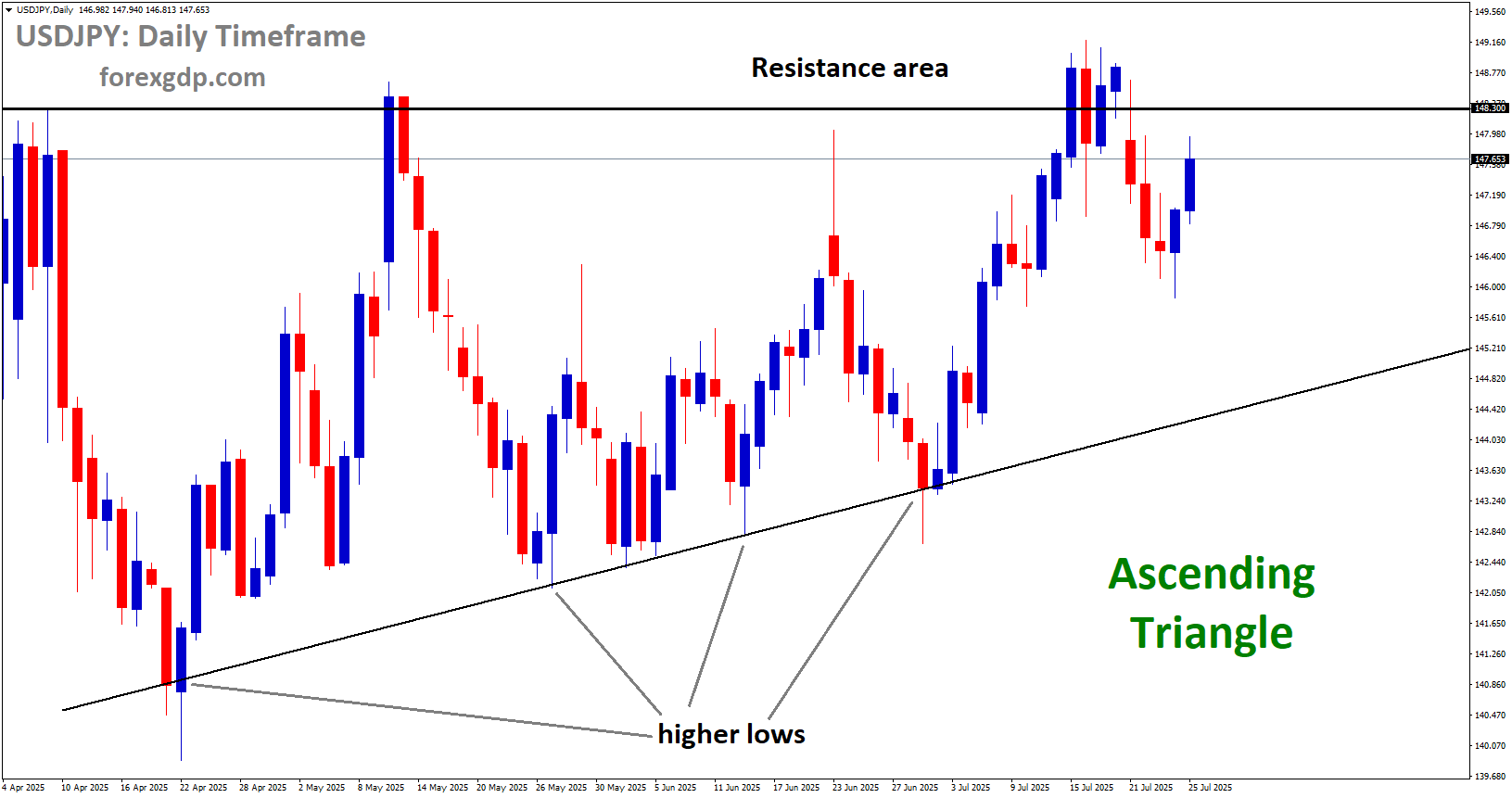
USDJPY is moving in an Ascending Triangle pattern
Global Mood: Risk-On Means Risk-Off for the Yen
One of the biggest influences on the USD/JPY movement right now is market sentiment — and that’s a fancy way of saying how people are feeling about taking risks.
Investors Are More Willing to Take Risks
Right now, global markets are in a bit of a “risk-on” phase. That means investors are feeling more confident and willing to move their money into things like stocks, high-yield bonds, or other assets that can bring higher returns. When this happens, safer options — like the Japanese Yen — often get pushed aside. The Yen has long been known as a “safe-haven” currency. It typically shines when there’s fear or uncertainty. But when the sun is out and markets are optimistic? The Yen usually takes a step back.
Yen Becomes Less Attractive
That’s exactly what’s happening now. Investors are turning to the US Dollar because it’s backed by higher interest rates and a stronger economy. The result? USD/JPY is on the rise, and the Yen is getting weaker.
Central Bank Watch: Fed vs. BoJ — A Tale of Two Policies
This is where things get really interesting — and where the real tug-of-war lies. The US Federal Reserve (the Fed) and the Bank of Japan (BoJ) are moving in completely different directions when it comes to how they handle interest rates.
The Fed Is Staying Firm
The Fed has been clear: they’re keeping interest rates higher for longer. Why? Because the US economy is still running relatively strong and inflation is showing signs of sticking around. So, the Fed is being extra cautious and doesn’t want to cut rates too soon. This high interest rate environment keeps the Dollar strong, because investors earn better returns by holding assets in USD.
The BoJ Is Still Playing It Safe
On the other hand, the BoJ is moving with extreme caution. Even though Japan’s inflation is showing signs of stabilizing, the central bank isn’t in a rush to tighten things up. In fact, the latest data from Tokyo’s July Consumer Price Index (CPI) showed inflation softening slightly — which gave the BoJ even more reason to hold off on making big moves. That difference in approach is creating a bigger gap between US and Japanese interest rates, which only fuels the Dollar’s strength over the Yen.

It’s not just policy talks and moods in the air that are driving this trend. Recent data from both the US and Japan is also shaping the narrative.
Japan’s Inflation Slows Down
As mentioned earlier, Japan’s inflation rate came in a bit lower than expected. That’s a key signal for the BoJ. Lower inflation gives them less urgency to change their ultra-loose monetary policy. And when rates stay low, the currency typically weakens. That’s exactly what’s happening with the Yen.
US Durable Goods: Not Great, But Not a Disaster
Over in the US, durable goods orders — which tell us how much businesses are investing in big-ticket items — took a hit. But even though the numbers showed a noticeable dip, it wasn’t as bad as the market had braced for. This kind of mixed data helps keep the Dollar steady rather than shaking confidence. Investors were already prepared for a correction after a sharp rise in the previous month, so the impact was muted.
The Bigger Picture: What This Means for You
If you’re wondering what all of this means beyond just charts and tickers, here’s the deal — USD/JPY’s rise isn’t random. It’s being driven by a perfect storm of investor confidence, policy gaps, and economic data. Whether you’re trading or just keeping an eye on currency trends, understanding the “why” behind these moves can give you better insight into what might come next.
Why Traders Are Leaning Into the USD
Many traders are favoring the US Dollar right now simply because of the interest rate advantage. The more the Fed stays firm on its stance, the more the Dollar becomes the go-to pick. Even small changes in central bank tone or inflation figures can have a ripple effect on where currencies move.
BoJ’s Patience Might Fuel More Yen Weakness
With the BoJ likely to continue its cautious path, the Yen may not get much support unless there’s a shift in global sentiment or a surprise in Japan’s inflation trends. Until then, the market’s attention is laser-focused on how wide this interest rate gap will get.
Final Summary: What You Should Take Away
Right now, USD/JPY is climbing, and it’s not by chance. The market is reacting to a mix of stronger US economic performance, a firm Federal Reserve stance, and Japan’s ultra-cautious central bank policy. The risk-on mood in global markets is also adding pressure to the Yen, as investors shift their focus to higher-yielding, riskier assets like the Dollar.
Here’s what you should keep in mind:
-
When global markets are feeling bold, the Yen tends to take a backseat.
-
Interest rate differences between countries play a huge role in currency movements.
-
The Fed’s “higher for longer” policy is making the Dollar more attractive.
-
Japan’s low inflation and cautious central bank keep the Yen weak — for now.
Understanding these trends can help you stay ahead of the curve whether you’re trading currencies or just following the financial landscape. Keep an eye on upcoming central bank decisions, inflation reports, and market mood — they’ll tell you where this currency pair might be headed next.
USD Index Slips as Market Awaits Fed’s Next Move and Looming Tariff Timelines
Over the past couple of days, the US Dollar has been making a quiet but noticeable comeback. After a short slump, it’s picking up strength again—and it’s not just a coincidence. There are several factors working in the dollar’s favor, and they all trace back to one key theme: economic confidence.
Let’s talk about jobs first. Recently released data showed that fewer people are filing for unemployment benefits than expected. That means more folks are staying employed, which is always a good sign for any economy. Along with that, reports from American businesses—especially in manufacturing and services—have held steady. These reports, known as PMIs, are like a pulse check on economic activity, and they suggest that things aren’t slowing down as some had feared.
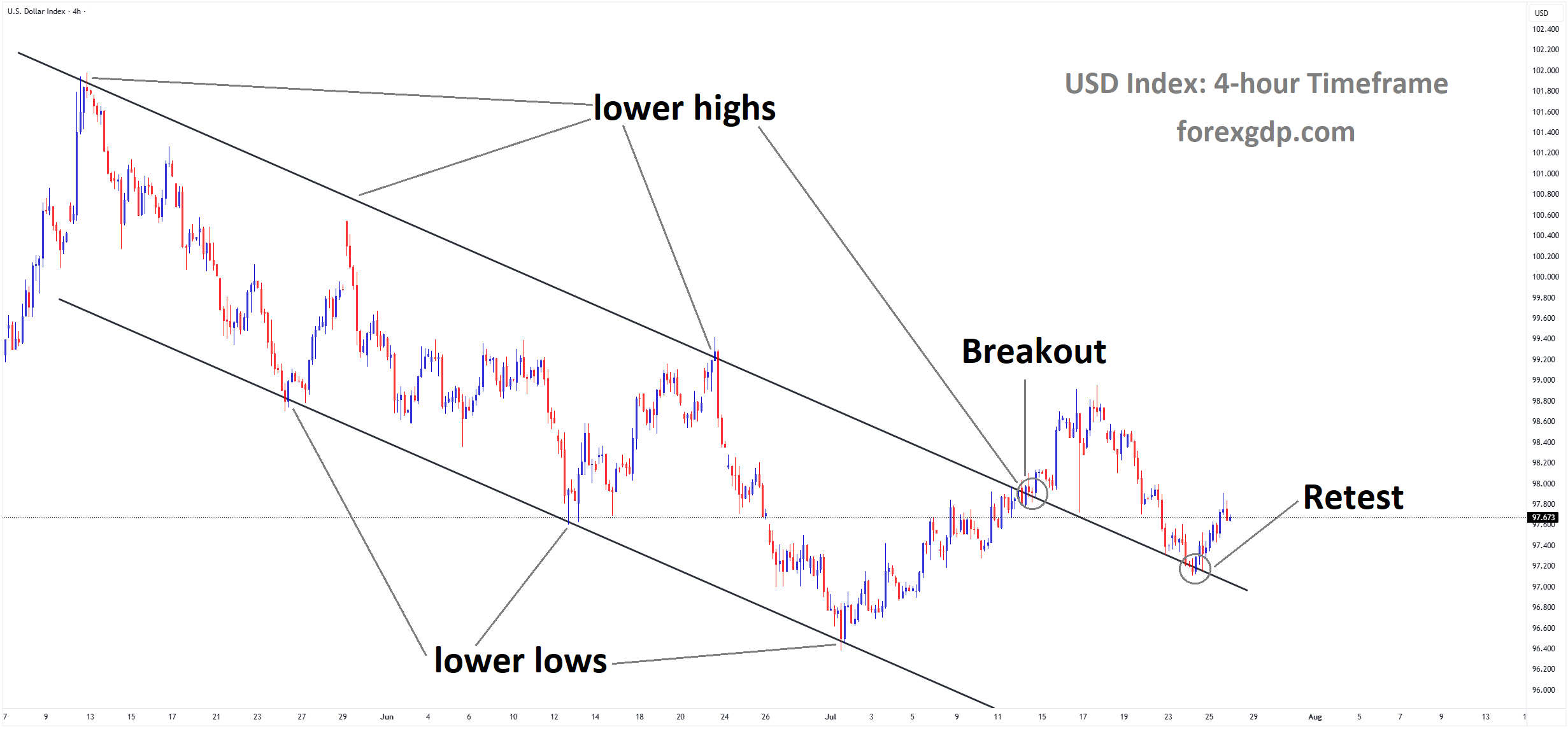
USD Index is rebounding from the retest area of the broken downtrend channel
When the economy shows signs of resilience, people naturally trust the currency more. Investors see strength in numbers—literally—and that helps the dollar gain momentum globally.
The Fed’s Big Decision Is Just Around the Corner
What’s All the Fuss About Interest Rates?
All eyes are now on the US Federal Reserve. Next week, they’re set to make another important decision about interest rates. These decisions may seem distant from everyday life, but they play a huge role in everything from credit card interest to mortgage rates and the value of the dollar.
Right now, expectations are that the Fed will keep interest rates where they are. That’s mainly because inflation is still a bit unpredictable. Also, political pressure is heating up, especially with the President visiting the Fed recently and publicly urging them to take action to support growth. The visit itself stirred up attention—it’s not often that a sitting US President drops by the Fed’s headquarters.
What made that visit even more interesting was the President’s suggestion that the Fed should be moving faster on cutting rates. While Fed Chair Jerome Powell has pushed back slightly, the speculation about rate cuts is now stronger than ever. A lot of traders believe a rate cut might come as soon as September, but the Fed is being cautious. They want to avoid moving too quickly and accidentally causing inflation to spike again.
Trade Talks Fueling Optimism — but Risks Remain
Tariff Talks Take Center Stage
Another major factor helping the dollar is all the noise—and progress—around trade. In recent months, the US has signed or advanced deals with countries like Japan, the Philippines, Indonesia, Vietnam, and the UK. That’s no small feat. These agreements are aimed at avoiding heavy new tariffs, and the general vibe in the market is positive as a result.
The big headline right now is a potential trade agreement with the European Union. Officials from both sides are deep into discussions, and some reports suggest that a framework agreement might be just around the corner. That could mean reduced tariffs and better market access on both sides of the Atlantic, especially for key industries like pharmaceuticals and automobiles.
Still, not everything is rosy. Trade relations with Canada are tense. The President recently mentioned that progress with Canada has been minimal and hinted at going ahead with tariffs unilaterally. If that happens, it could create some turbulence, especially for North American trade.

At the same time, South Korea is working overtime to avoid a harsh outcome. Representatives from Seoul are in Washington negotiating to finalize a trade deal, and they’ve even offered a massive investment package to sweeten the deal. Big players like Samsung and Hyundai are involved, which shows just how high the stakes are.
Political Drama Meets Economic Policy
Let’s not forget the political drama layered into all this. During his visit to the Fed, the President didn’t just talk about interest rates. He also made claims about the cost of a renovation project at the Fed’s headquarters, suggesting that it had gone over budget. Fed officials quickly corrected the numbers, but the whole thing added fuel to the ongoing debate about how independent the central bank really is.
The political angle isn’t just limited to the US. Global trade discussions are deeply tied to diplomacy, and countries are negotiating not just for fair economic terms but also for influence and alignment. The President’s visit to Scotland and planned meeting with the UK Prime Minister highlights this intersection of politics and economic policy. While it’s being pitched as a routine visit, trade and tariffs are definitely high on the agenda.
There’s also talk of more aggressive tariffs in the future—ranging from 15% to 50%—for countries that don’t open their markets to US goods and services. That’s a pretty tough stance and could trigger retaliatory moves if not handled carefully.
Is the Dollar’s Strength Here to Stay?
The million-dollar question now is: will the US Dollar continue to stay strong?
Short-term, the answer looks like a yes. The economy is showing resilience, and with multiple trade deals either finalized or in the works, investor confidence in the dollar remains steady. The expectation that the Fed will take action to support growth—either by holding or eventually cutting rates—also adds a layer of stability.
Long-term, though, it depends on a few things:
-
Inflation trends: If inflation spikes again, the Fed might have to rethink rate cuts.
-
Trade friction: Any major fallout from tough trade talks could shake things up.
-
Global growth: If other major economies recover strongly, the dollar could face more competition.
There’s also a bit of a tug-of-war within the Fed itself. Some members are in favor of cutting rates soon to protect against slower growth, while others—like Chair Powell—are urging patience. This internal debate could shape the direction of the dollar in the months ahead.
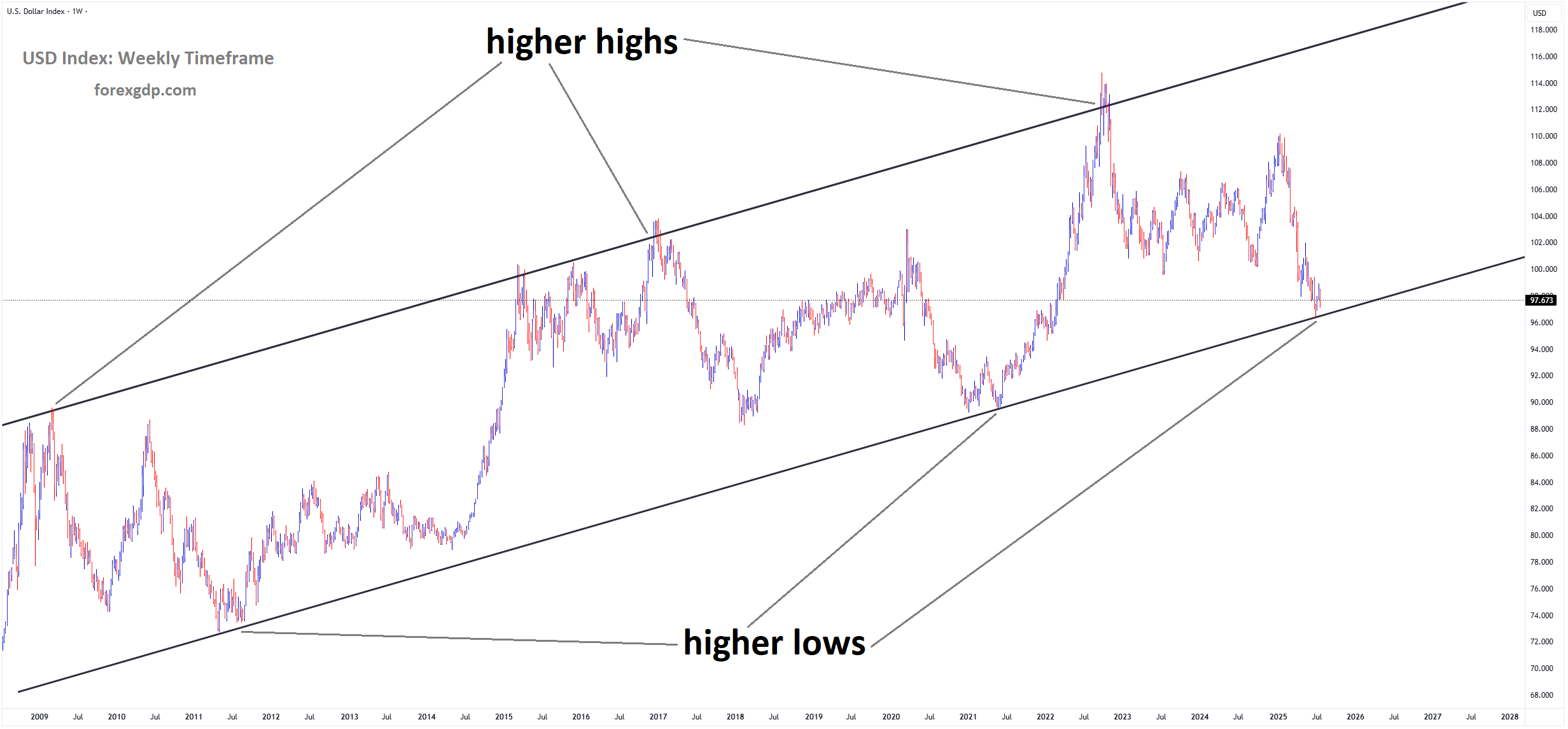
USD Index Market price is moving in an Ascending channel, and the market has reached a higher low area of the channel
What You Should Keep an Eye On
If you’re someone who watches the markets, plans international travel, or deals with imports and exports, there are a few key things to keep in mind over the coming weeks:
-
The Fed’s policy announcement next week – This will set the tone for interest rates and possibly impact the dollar’s trend.
-
Progress (or breakdown) in trade negotiations – Especially with the EU, South Korea, and Canada.
-
Statements from the White House and the Fed – Political pressure on economic policy isn’t going away anytime soon.
Final Summary
The US Dollar is gaining ground once again, thanks to solid economic reports and hope around major trade deals. While there’s plenty of positive momentum, things are still a bit shaky with political pressure, ongoing tariff threats, and uncertainty around interest rates.
As we head into a crucial week filled with central bank decisions and international meetings, it’s a good time to stay alert. Whether you’re investing, trading, or just keeping an eye on global affairs, the next few days could shape the dollar’s path for the rest of the year.
USDCHF Holds Firm as US Economic Strength Offsets Trade Tensions
If you’ve been watching the currency market, you might’ve noticed something interesting — the Swiss Franc has been sliding for a few days now, while the US Dollar is gaining strength. This isn’t just a random fluke. There are a few solid reasons behind this shift, and if you’re curious about why it’s happening, you’re in the right place.
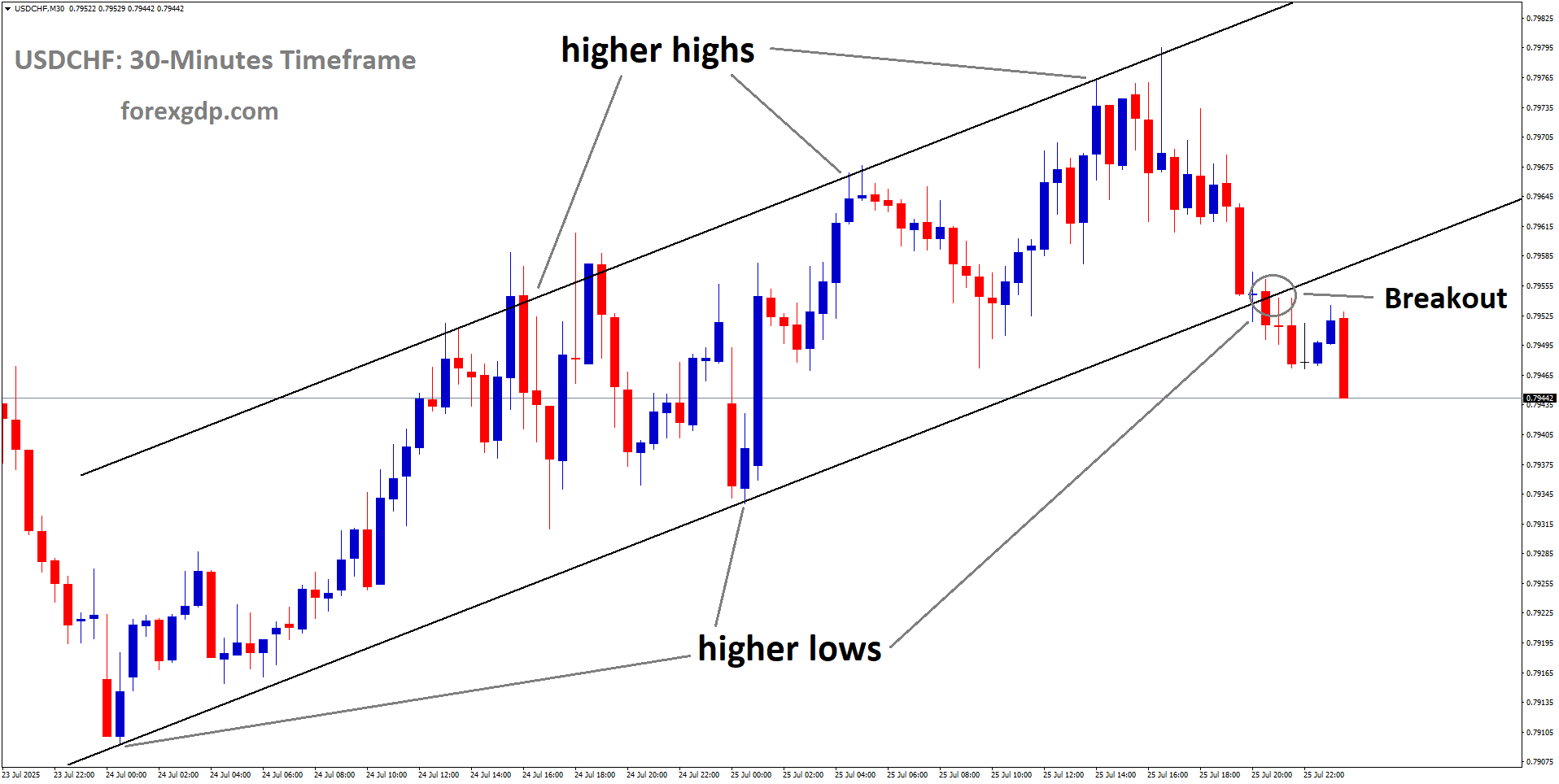
USDCHF has broken the Ascending channel on the downside
The Swiss Franc has long been considered one of the safest currencies in the world. People turn to it when they’re nervous about global markets or uncertain about economic policies. But that safe-haven status also means the Franc tends to drop when the world starts feeling a little more optimistic.
And that’s exactly what’s happening right now.
Renewed Trade Optimism Is Changing the Game
When there’s positive news about global trade, people naturally feel more confident about the future. They take more risks. And in the world of finance, that usually means investing in assets or currencies that have higher potential returns — and moving away from safe, steady options like the Swiss Franc.
This week, there’s been a wave of fresh optimism in the market, especially thanks to announcements from the United States. US President Donald Trump recently shared that most of the country’s ongoing trade deals are now complete. That’s a big deal because it suggests there might be a turning point in what has been a long period of global trade tension.
Here’s a quick breakdown of what’s creating this hopeful mood:
-
Multiple new trade agreements have been finalized between the US and key partners like Japan, Indonesia, and the Philippines.
-
Talks with the European Union are showing promise. Trump said there’s a 50/50 chance of a successful deal soon, and EU diplomats have hinted something could be announced very soon.
-
China negotiations also seem to be progressing. Trump stated that the US is “nearing” a deal with China, which adds even more fuel to the fire of global optimism.
When investors see this kind of progress, they feel encouraged to seek opportunities in riskier markets. That shift in mindset makes demand for safe-haven currencies like the Swiss Franc drop, while demand for currencies tied to stronger economic performance — like the US Dollar — rises.
US Dollar Gets a Boost From Strong Data and Stable Policy Expectations
Besides trade optimism, the US Dollar is also being powered by something closer to home: the state of the American economy.
Even though some data points are showing signs of slowing, the broader picture is still pretty solid. This gives investors confidence that the US Federal Reserve is likely to maintain steady interest rates — a factor that tends to support the Dollar.
Let’s look at what’s been happening on the US economic front:
Job Market Still Looks Solid
The number of Americans filing for unemployment benefits came in lower than expected. That suggests the job market remains tight, meaning more people are working, spending money, and contributing to economic growth. That’s a great sign for the US economy and naturally makes the US Dollar more attractive.

Mixed but Balanced Business Activity
There’s been a bit of a dip in manufacturing activity based on recent reports, but services — which make up a big part of the US economy — are still going strong. The Services PMI, which measures how businesses in the services sector are doing, stayed well in the growth zone. This helps balance out concerns from the weaker manufacturing numbers and keeps overall investor confidence in the US steady.
Durable Goods Data Surprises (Sort of)
While orders for long-lasting goods like machinery and vehicles fell in June, the drop wasn’t as bad as some had predicted. This decline mostly came from fewer aircraft orders, which can be pretty volatile month to month. So, while the headline number was down, it didn’t spark much panic — and again, helped support the Dollar.
Why Is the Swiss Franc Falling If Its Economy Isn’t in Trouble?
That’s a fair question. The answer lies in how global currencies are viewed in the big picture.
The Swiss Franc hasn’t suddenly become weaker because Switzerland’s economy is struggling — in fact, it remains one of the most stable economies globally. Instead, the decline is about what investors want in the moment.
When times feel uncertain, people go for safe bets like the Swiss Franc. But when trade tensions ease and economic news sounds hopeful, those same people start looking for higher returns — and they often find those opportunities elsewhere.
The US, with its strong labor market and relatively resilient business activity, is offering one of those “higher return” stories right now. So, investors are naturally shifting back toward the Dollar.
Trouble Brewing With Canada? Not Everyone’s Getting Along
While the US is making headway with several trade partners, it seems things aren’t so smooth with Canada. Trump has made it clear that progress is limited, even hinting at imposing tariffs without further negotiation. That kind of hardline stance creates tension and adds uncertainty — but oddly enough, it hasn’t been enough to push people back toward the Swiss Franc.
That shows just how powerful the broader wave of trade optimism really is right now.
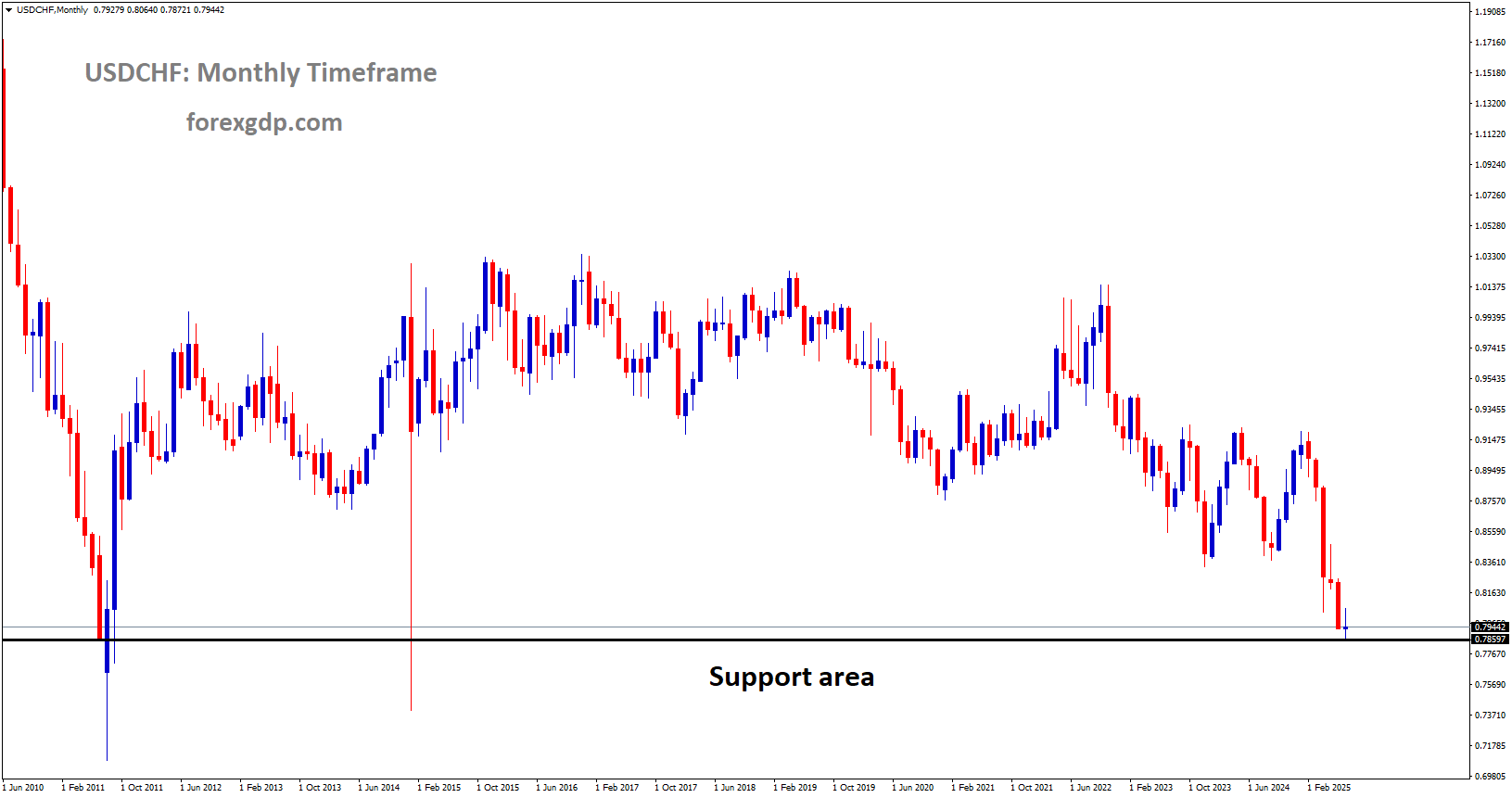
USDCHF reached a major support area
Final Thoughts: Why This Matters to You
So, what does all this mean for you — especially if you’re a trader, investor, or someone just keeping an eye on currency trends?
In simple terms, we’re seeing a classic market shift. The world is feeling a bit more optimistic thanks to trade progress, and that’s prompting people to take more risks. As a result:
-
The Swiss Franc is weakening as fewer investors seek safety.
-
The US Dollar is gaining because of strong economic data and trade optimism.
-
Safe-haven demand is fading — at least for now.
These shifts can open up opportunities, but they also mean the environment is changing quickly. Staying tuned into economic signals, policy decisions, and global headlines will help you stay ahead of the curve.
Remember, markets move not just because of what’s happening right now — but because of what people expect will happen next. Right now, the expectation is that things are getting better, and that’s tipping the balance away from safety and toward growth. Let’s see how long that feeling lasts.
USDCAD Pushes Upward Following Trump’s New Trade Pressure on Canada
The Canadian Dollar isn’t having the best time lately, especially against the US Dollar. If you’ve been keeping an eye on the headlines, you might have noticed the Loonie (as the Canadian Dollar is affectionately called) dipping lower, especially toward the end of the week. Let’s break down why that’s happening, what’s driving all this tension, and what it could mean moving forward — all in simple, plain terms.
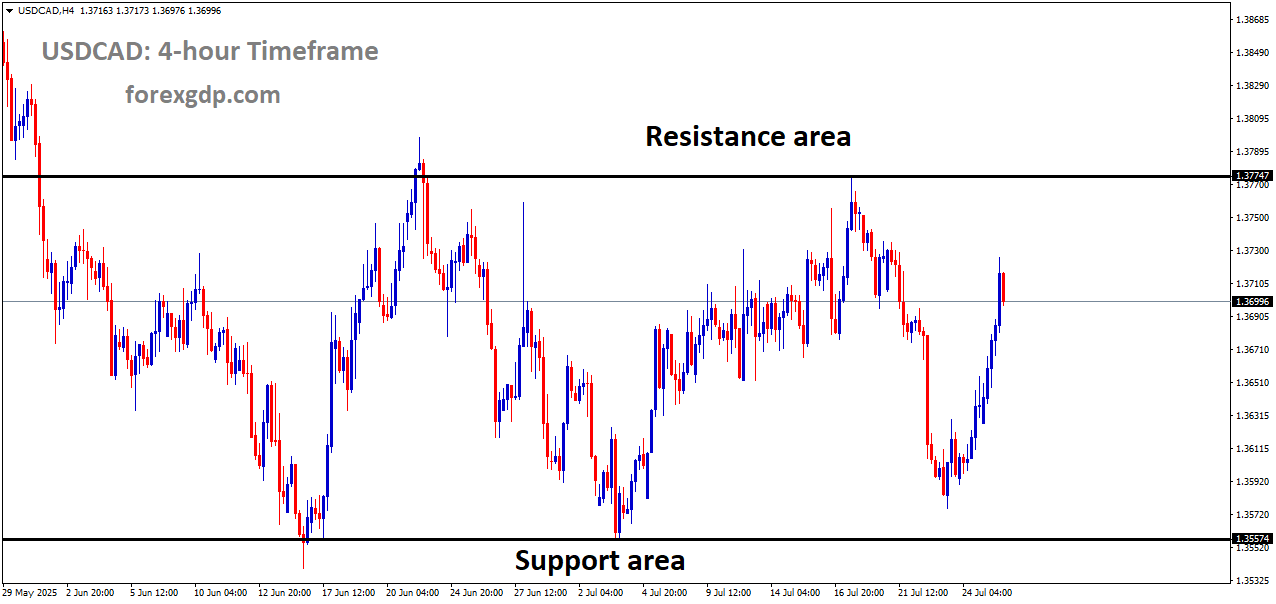
USDCAD is moving in a box pattern
A Stormy Week for the Canadian Dollar
The Canadian Dollar has been slipping for two days in a row, and Friday marked another tough session. What’s behind this backslide? It’s mostly got to do with growing concerns over trade relations between Canada and the United States.
Just when things seemed like they might be smoothing out, former President Donald Trump made headlines again with renewed threats of tariffs aimed at Canadian goods. His administration had already set a deadline — August 1 — to put these tariffs into motion unless better trade terms could be secured. But Canada hasn’t really budged on those negotiations, and that’s created a lot of nervous energy in the currency markets.
Traders don’t like uncertainty. And when a major trade partner starts rattling the tariff sword again, it’s natural for investors to pull back from the Canadian Dollar.
Trade Troubles Are Back at the Forefront
The Loonie’s dip isn’t just about numbers and stats — it’s about global politics, trade disputes, and a whole lot of unpredictability. Here’s why it matters:
1. Tariff Tensions Are Heating Up Again
Donald Trump’s renewed focus on slapping tariffs on Canadian imports has left markets uneasy. While there’s nothing confirmed yet, just the threat of tariffs can shake confidence. These proposed tariffs are part of Trump’s broader push for what he calls “reciprocal trade” — essentially, if one country charges the US high tariffs, he believes the US should do the same back.
Even though his administration has already renegotiated NAFTA into what’s now called USMCA, Trump’s dissatisfaction with the current state of trade with Canada remains clear. He’s voiced frustration about Canada not being cooperative in reaching new terms, and that has added more fuel to this already tense situation.
2. Canada’s Response Has Been Muted
While Trump has been vocal, Canada hasn’t made many strong counter-moves. Their slower response in dealing with the tariff threats has raised eyebrows. Whether this is a strategic silence or just a lack of urgency is hard to say, but investors see it as a red flag. When one side seems unwilling or slow to engage, the fear is that things might get worse before they get better.
3. Investors Are Looking for Safer Ground
When markets get jittery, especially over trade disputes, investors tend to move their money into safer places. The US Dollar often becomes the go-to currency during such times. That shift in demand naturally pushes the US Dollar higher and the Canadian Dollar lower — even if nothing new has technically happened yet.

The Broader Picture: Not Just About Canada
While Canada and the US are at the center of this story, it’s worth noting that global markets are watching a few other pieces too.
Durable Goods Data in the US
Over in the States, the latest numbers for durable goods orders (things like cars, appliances, and machinery) came in slightly better than some expected. Though they still showed a decline, it wasn’t quite as bad as feared. That modestly positive news gave the US Dollar a bit more strength — which, in turn, made the Canadian Dollar’s fall look even steeper.
Rumblings in US-EU Trade Talks
There’s also some chatter about progress in trade discussions between the US and the European Union. While nothing official has come out, just the possibility of a breakthrough gave the US Dollar more support. And again, when the Greenback strengthens, the Loonie often weakens — it’s a simple case of see-saw dynamics.
What Traders and Investors Are Watching Now
So, what’s next? What should people be watching for if they care about where the Canadian Dollar might be headed?
-
Tariff News: Will Trump actually go through with the new tariffs on August 1? Or will there be another delay? If he pulls the trigger, expect more downward pressure on the Loonie.
-
Canada’s Response: Will Canadian leadership make a public move to re-engage in talks or propose something new? If so, that could calm some nerves and give the Loonie a boost.
-
US Economic Updates: As more data comes out of the US, including jobs reports, manufacturing numbers, and inflation figures, that will impact the US Dollar’s strength — and by extension, the Canadian Dollar’s movement.
-
Global Risk Appetite: If global markets start to get more optimistic (perhaps due to a trade breakthrough somewhere else), demand for riskier currencies like the Canadian Dollar could go back up.
A Quick Recap: Why the Loonie Is Struggling
-
Trump is threatening new tariffs on Canadian goods.
-
Canada hasn’t moved much to change the situation.
-
Investors are reacting to the uncertainty by shifting their money to the US Dollar.
-
Other small bits of economic data are also helping the US Dollar gain strength.
This mix of political tension, market nerves, and a slightly better outlook for the US economy has all contributed to the Canadian Dollar’s recent struggles.
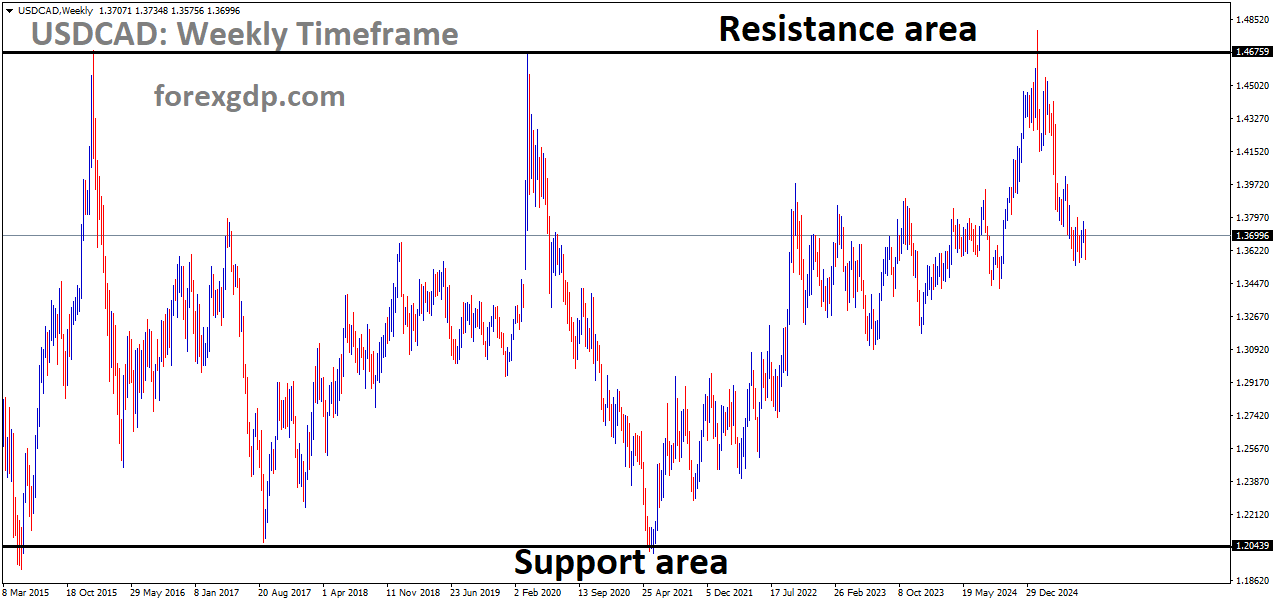
USDCAD is moving in a box pattern, and the market has fallen from the resistance area of the pattern
Final Thoughts: A Currency Caught in a Crossfire
The Canadian Dollar is clearly feeling the pressure, and for now, it’s largely because of political noise rather than anything fundamentally broken in Canada’s economy. Tariffs and trade spats have a way of rattling even the strongest markets, and right now, that’s exactly what’s happening.
If cooler heads prevail and some sort of understanding can be reached before the August 1 deadline, the Loonie could see a bounce back. But if things heat up instead, it might be a rougher ride ahead.
Either way, for those watching the currency markets — or just curious about what’s going on — it’s a good reminder of how much global politics can influence the strength of a currency. It’s not just about numbers. Sometimes, it’s about who says what — and when they say it.
EURCAD Pushes Higher with ECB Holding Steady on Rates
The EUR/CAD pair has been on the move lately, drawing attention from traders and market watchers alike. But what’s really going on behind the scenes? If you’ve been wondering why this currency pair is gaining ground, you’re in the right place. Let’s dive deep into the story behind the Euro’s recent strength against the Canadian Dollar and uncover the factors that are driving this upward trend.

EURCAD is moving in an Ascending channel, and the market has fallen from the higher high area of the channel
ECB Holds Steady: A Wait-and-Watch Approach
The European Central Bank (ECB) made headlines recently by keeping its interest rates unchanged. Now, you might be thinking—so what? Well, when a central bank like the ECB makes a decision like that, it signals a lot about how they view the economy.
What the ECB Is Saying
The ECB clearly isn’t in a rush to make bold moves. Instead, they’re choosing to observe how the economy behaves in the coming weeks and months. In simpler terms, they’re hitting the pause button. While inflation seems to be cooling down as expected, the ECB still wants to gather more data before giving any firm clues about the future of its policy.
This cautious stance has actually given the Euro a bit of support. Investors often prefer stability, and the ECB’s approach signals that they’re managing things carefully, which can boost confidence in the Euro.
Canada’s Retail Sales: A Letdown for the Loonie
On the flip side, the Canadian Dollar—also known as the Loonie—has had a bit of a rough patch, especially after the latest retail sales numbers came in.
What the Numbers Showed
Canada’s retail sales for May dropped by 1.1% from the previous month. That’s a pretty clear sign that consumers might be spending less. Even more telling is that retail sales excluding auto purchases also went down, which shows that it wasn’t just car sales dragging the numbers down—it’s a broader trend.
When consumers spend less, it usually means the economy might be slowing down. That can be a red flag for investors and tends to weaken the currency. In this case, the disappointing retail data added pressure on the Canadian Dollar, making the Euro more appealing by comparison.
Oil Prices Could Give CAD a Boost—But Not Just Yet
Now here’s where things get a little more interesting. The Canadian economy is closely tied to oil. When oil prices go up, the Canadian Dollar usually gets a lift because Canada is a major oil exporter.

Why Oil Prices Matter
Recently, crude oil prices have been inching higher. That’s typically good news for the Loonie. The optimism around global trade talks has boosted hopes for stronger oil demand, which helps push prices up. However, despite this potential tailwind, the Canadian Dollar hasn’t been able to fully capitalize on it—at least not yet.
The current gains in EUR/CAD suggest that the market is more focused on Canada’s weak retail performance and the ECB’s cautious but steady hand, rather than the short-term movement in oil prices.
What’s Really Moving EUR/CAD Right Now
So, what’s the main takeaway here? Why is EUR/CAD on the rise despite positive oil movements?
-
Steady ECB Stance: The ECB’s decision to maintain rates shows stability, which tends to attract investor confidence.
-
Weak Canadian Data: Canada’s disappointing retail sales suggest a slowdown, which weighs heavily on the Loonie.
-
Mixed Signals from Oil: While oil prices are showing strength, they haven’t been strong enough to offset the negative sentiment from other Canadian economic indicators.
Together, these factors are painting a picture of a stronger Euro and a weaker Canadian Dollar in the short term.
The Bigger Picture: What Traders Should Keep an Eye On
If you’re someone who watches the currency markets closely—or even just casually—this is a good time to pay attention to a few things that could influence where EUR/CAD heads next.
1. More Economic Data from Europe
The ECB has made it clear: they’re watching the data. So, upcoming economic reports from the Eurozone will matter a lot. If inflation keeps cooling and growth stays steady, the Euro could continue to benefit from a perception of economic resilience.
2. Canadian Economic Recovery
For the Canadian Dollar to bounce back, we’ll need to see stronger numbers from Canada—especially in areas like retail, employment, and GDP growth. Right now, the weak retail figures are holding the Loonie back.
3. Global Trade Developments
Hopes for smoother global trade are helping oil prices stay afloat. If trade relations improve further, especially between major economies like the U.S. and China, oil demand could climb—boosting the Canadian Dollar in the process.
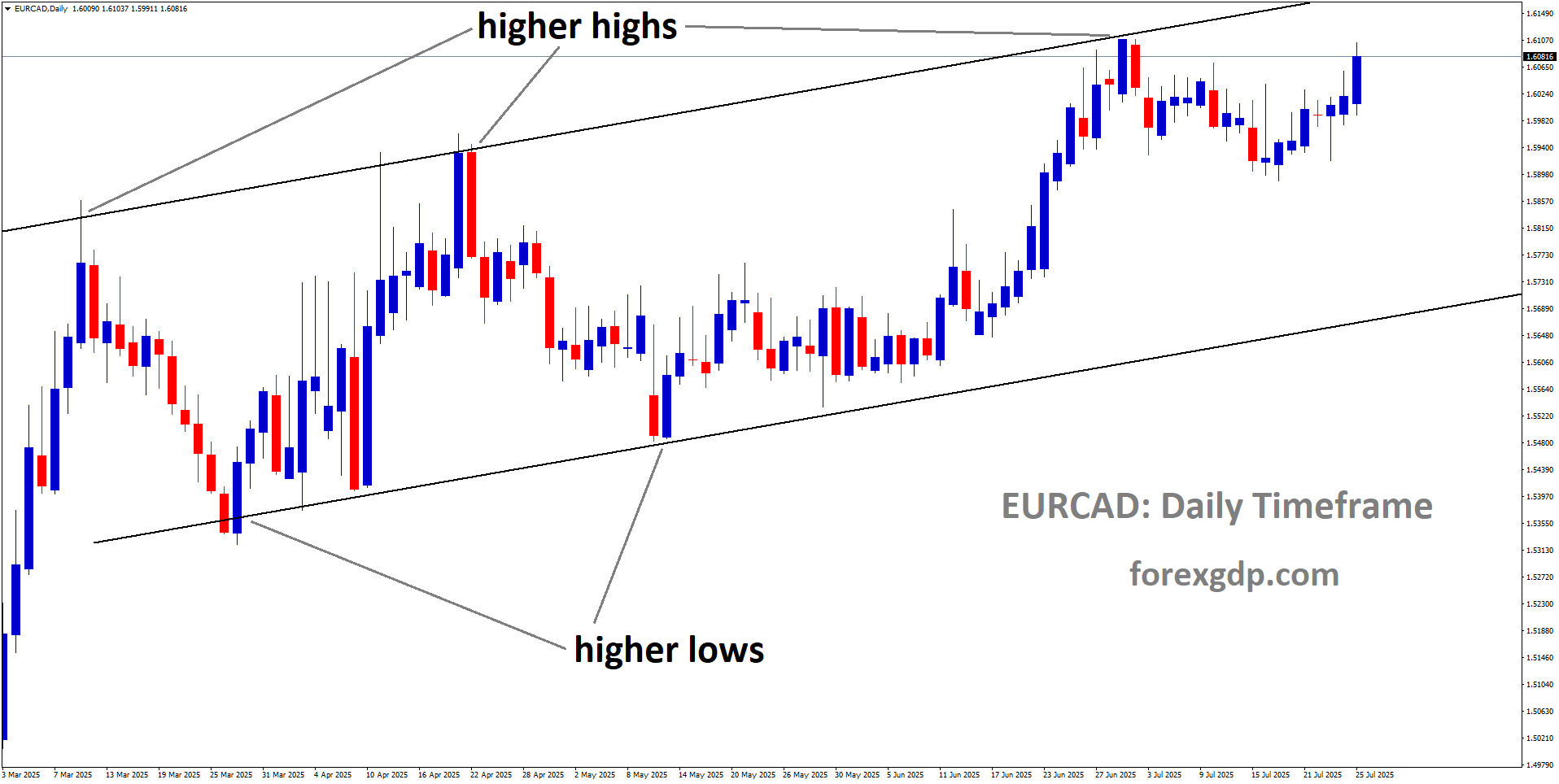
EURCAD is moving in an Ascending channel
Wrapping It Up: EUR/CAD’s Momentum Explained
EUR/CAD’s recent strength isn’t just about one single event. It’s the result of a combination of influences from both sides of the currency pair. On one side, we have the Euro holding steady thanks to a cautious but clear message from the ECB. On the other, the Canadian Dollar is feeling the heat from disappointing retail figures and uncertainty despite a small bump in oil prices.
If you’re a trader or someone interested in how global events shape currency movements, this is a perfect example of how economic policies and data releases directly influence the markets. Keep your eye on upcoming European and Canadian updates, and you’ll have a better sense of where EUR/CAD might be headed next.
And there you have it—a full look at why EUR/CAD is climbing and what could come next. Stay tuned, because the story is far from over.
AUDUSD Drifts Lower Following Dollar Rally and Fading Bullish Drive
If you’ve been watching the Aussie Dollar (AUD) slide against the US Dollar (USD) recently, you’re not alone. A lot of traders and investors are scratching their heads over what’s causing this sudden change. After all, AUD/USD had climbed to its highest point this year, but just as quickly, it started to dip again. So, what gives?
Let’s break down exactly what’s going on in a way that actually makes sense. No technical jargon, no complicated charts—just a real talk about why the Aussie is stumbling and what the US Dollar has to do with it.
The US Dollar’s Comeback Story
The US Dollar has been gaining strength, and it’s not just out of nowhere. There are a couple of solid reasons for the recent surge in demand for the USD, and one of the biggest ones is rising US Treasury yields.
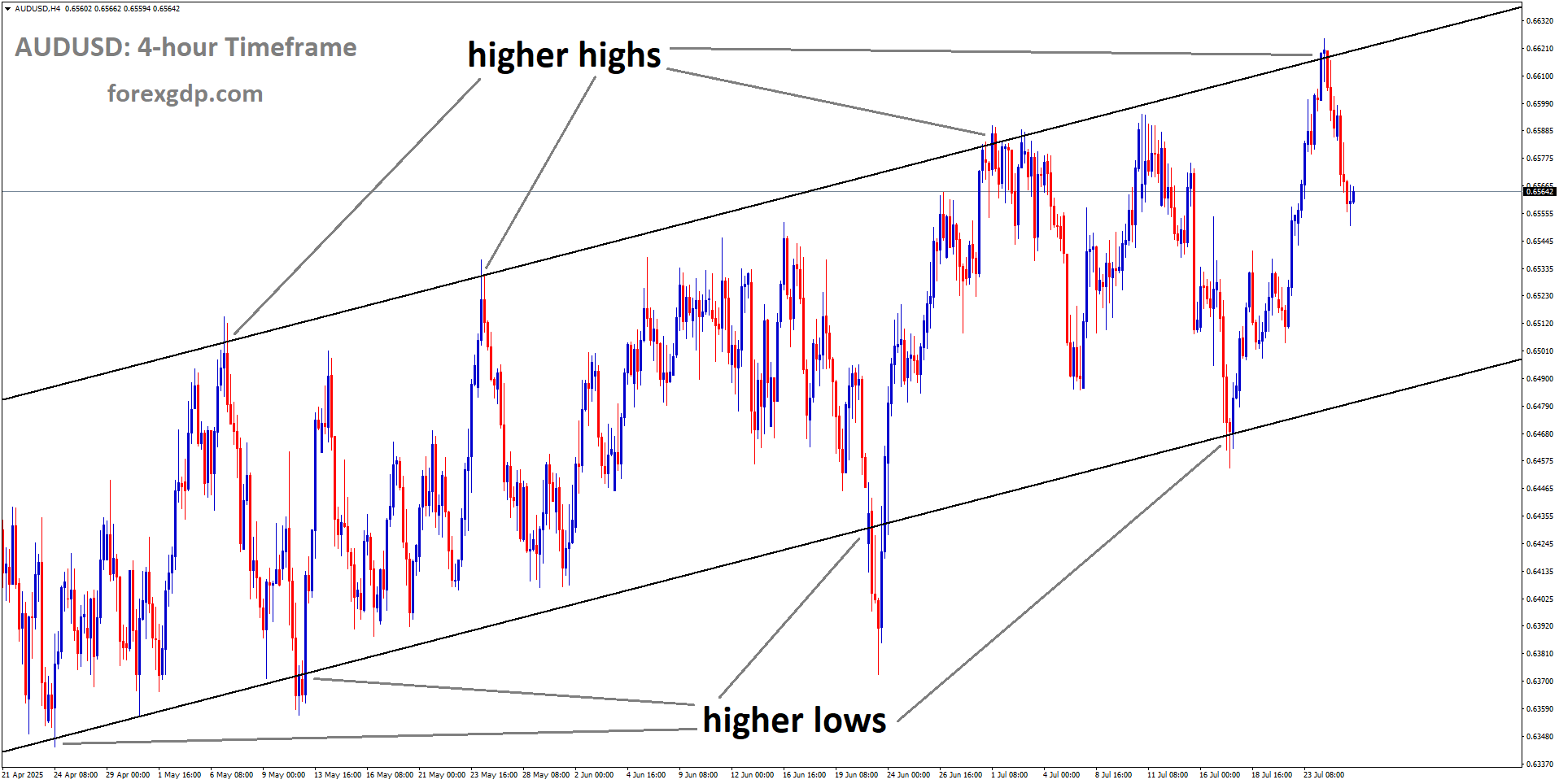
AUDUSD is moving in an Ascending channel, and the market has fallen from the higher high area of the channel
What’s the Deal With Treasury Yields?
When Treasury yields go up, it usually means investors are expecting higher returns from US government bonds. That gets global investors excited about holding more US assets. And guess what? To buy those assets, they need US Dollars. This extra demand naturally pushes the value of the Dollar higher.
When this happens, other currencies like the Aussie Dollar tend to feel the pressure. Investors shift money out of riskier currencies and into the Greenback (a common nickname for the US Dollar), which is seen as a safe and stable option.
Trade Talks: Fuel to the Dollar’s Fire
Another reason the US Dollar has been riding high is optimism around trade talks. It’s no secret that when countries like the US and China or the US and the European Union start having productive conversations, markets tend to calm down.
Recently, both the US and China have made moves to keep the lines of communication open. High-level discussions are happening in Stockholm between American and Chinese officials, with the goal of pushing forward their existing trade agreement. These talks are expected to continue over a few days, and while nothing is guaranteed, the very fact that both sides are engaging positively has given the US Dollar some serious momentum.
And it’s not just China. Hints of possible progress in discussions between the US and the European Union are also adding to that positive outlook. All of this builds confidence in the US economy, making the Dollar even more attractive.
The Fed Factor: Why Everyone’s Watching the Central Bank
All eyes are now turning toward the upcoming Federal Reserve decision. The Fed is the central bank of the US, and it plays a major role in setting interest rates. When those rates are high—or expected to stay high—investors typically lean toward the US Dollar because it means they’ll get better returns.

So, what’s happening right now?
Even though there’s pressure from various angles for the Fed to lower interest rates, the central bank seems committed to keeping them where they are for the time being. That’s because the US economy has remained relatively strong, and inflation, while cooling, is still something they’re watching closely.
Keeping interest rates steady has helped support the Dollar. Investors feel reassured that the Fed is holding its ground, and that helps reduce uncertainty—something markets absolutely hate.
AUD Takes a Breather After a Strong Run
The Australian Dollar had a good run recently, climbing to its highest point this year. But no rally lasts forever, and right now, the AUD is pulling back a bit. Some of this comes down to simple market dynamics.
When a currency gets too strong too quickly, traders often take profits—that means they sell off their positions to lock in gains. This selling pressure can naturally bring the currency down in the short term.
On top of that, with the US Dollar looking stronger and more appealing, there’s less incentive for investors to keep holding onto the Aussie Dollar. So, while this doesn’t mean the AUD is doomed, it does suggest we might see more back-and-forth action in the near future.
What To Watch Going Forward
Now that the AUD/USD pair is on the move, what should traders and investors keep an eye on?
-
US Federal Reserve Meeting: The Fed’s decision on interest rates is expected soon. If they hold steady, the Dollar could continue to get stronger. If they surprise the market in any way, that could shake things up.
-
Trade Negotiation Headlines: Any new developments between the US and China—or even between the US and Europe—will have a direct impact on the Dollar’s strength and, in turn, the AUD/USD pair.
-
Investor Sentiment: Don’t underestimate the role that emotions play in the market. Confidence in the US economy is fueling a lot of the recent moves. If that confidence takes a hit, so could the Dollar’s rally.
Final Thoughts: A Tug of War Between Confidence and Caution
Right now, we’re seeing a real tug of war between the Aussie Dollar’s recent strength and the growing appeal of the US Dollar. Rising US Treasury yields, steady Fed policy, and improving trade relations have all added fuel to the Greenback’s comeback.
Meanwhile, the Australian Dollar is cooling off after hitting a major milestone. That doesn’t necessarily mean it’s headed for a big fall—it just means the market is adjusting. A bit of a breather is completely normal.
The big takeaway here? Keep an eye on the Fed and trade developments. These are the forces steering the ship at the moment, and they’ll likely continue to guide how AUD/USD behaves in the days ahead.
For now, the Dollar’s in the driver’s seat—but as we know, markets never stay still for long.
NZDUSD Dips as Dollar Recovers, Eyes Stay on Advancing US-China Negotiations
The New Zealand Dollar, also called the Kiwi, has had a bit of a rollercoaster week. It dropped for a second straight day by Friday, but overall, it still managed to show a gain over the course of the week. Sounds confusing? Let’s break it down.
Even though the Kiwi slid toward the end of the week, it actually started off pretty strong. There was a lot of buzz in the global markets about progress on international trade agreements, especially involving the United States. This kind of optimism typically boosts currencies like the NZD that are seen as “risk-on” – meaning investors are more willing to take a chance when they feel confident about the world economy.
But partway through the week, the US Dollar began to regain some power, mostly due to strong economic data coming out of the US. That made it harder for the Kiwi to keep climbing, despite the overall good vibes in the market.
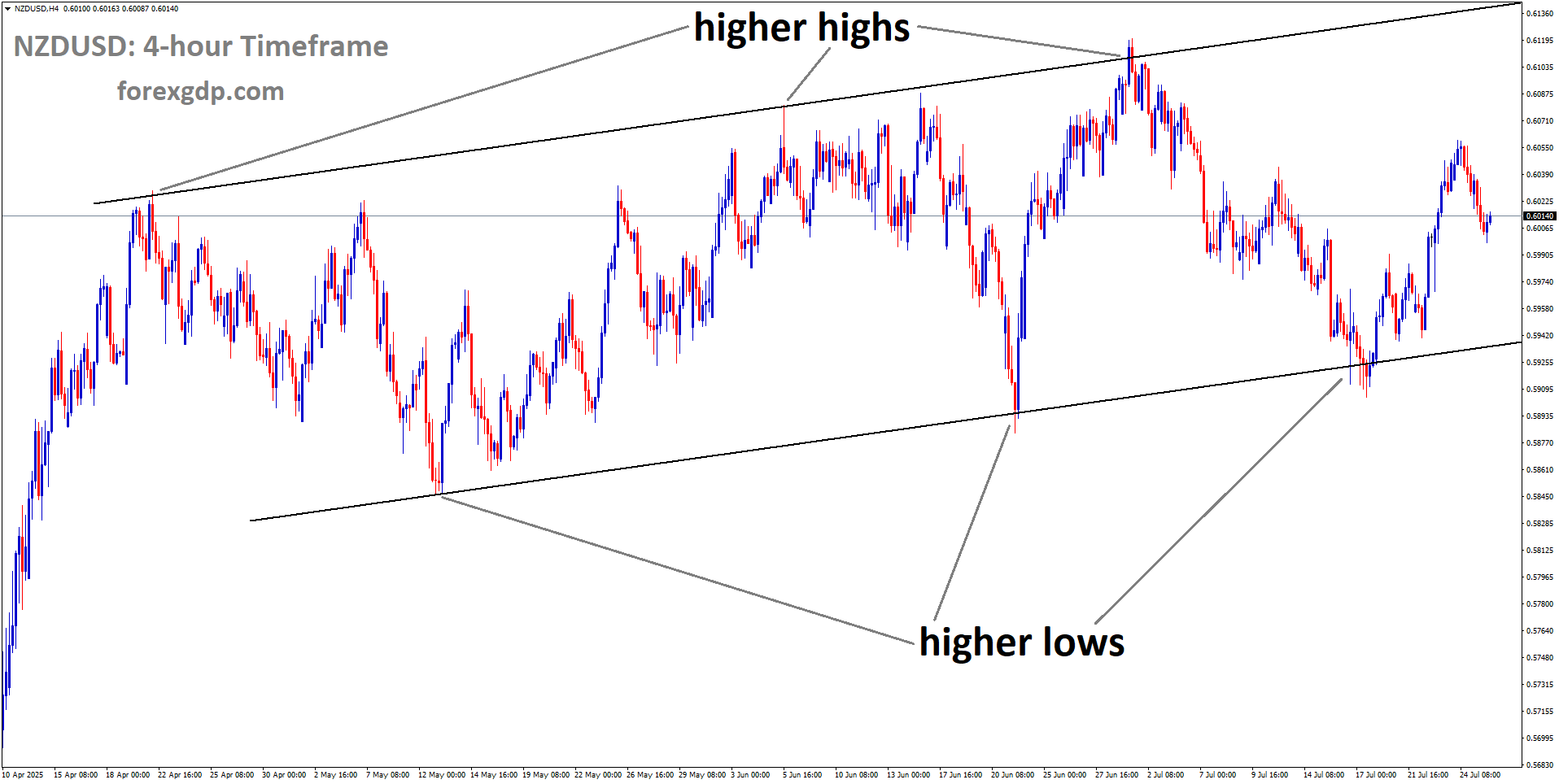
NZDUSD is moving in an uptrend channel, and the market has rebounded from the higher low area of the channel
US Trade Talks Stealing the Spotlight
One of the big factors this week was the improving tone around trade deals. The United States finalized agreements with Japan, Indonesia, and the Philippines – all positive steps that made investors feel a bit better about the global economy.
President Donald Trump made some bold statements, saying most of these trade agreements are already wrapped up. He mentioned that deals with many countries had been confirmed, even if they were just in the form of letters for now. He hinted there’s about a “50-50” chance of sealing a deal with the European Union and said that talks with China were close to the finish line.
That kind of language tends to make investors feel upbeat. When people believe trade tensions are easing, they’re more likely to put their money into currencies like the NZD that are linked to global trade and commodity exports.
Why Is The Kiwi Still Feeling Pressure Then?
So if trade talk is so positive, why is the New Zealand Dollar still under pressure? Well, the answer lies in a couple of key places.
1. US Dollar Makes A Comeback
Midway through the week, strong economic numbers came out of the US, making the Dollar attractive again. When the Greenback strengthens, currencies like the NZD often take a backseat. Investors tend to pile into what’s seen as a safer bet, especially if it looks like the US economy is staying hot.
Add to that the fact that the US Federal Reserve is expected to keep interest rates steady for now. That means the returns on US assets might still look pretty good compared to those in countries like New Zealand, where rate cuts are still on the table.

2. Rate Cut Speculation in New Zealand
Another drag on the Kiwi? The market seems to believe that the Reserve Bank of New Zealand (RBNZ) might lower interest rates soon. There’s a strong chance – around 75% – that the central bank could cut rates by 25 basis points in its next policy meeting.
That kind of move generally weakens a currency. Lower rates make investments in that country less appealing because the potential returns are smaller.
However, there’s a twist. Many investors think the RBNZ is near the end of its rate-cutting cycle. This belief has helped cushion the Kiwi a bit, even as speculation of another cut grows.
A Peek at What the Experts Are Saying
RBNZ’s Chief Economist Paul Conway gave a bit of insight this week that helped shape expectations. He said the bank is still open to more cuts – especially if inflation keeps dropping – but also signaled that things might be stabilizing. He warned, though, that rising tariffs from countries like the US could hurt demand across the globe. And when that happens, smaller economies like New Zealand’s usually take a hit, especially in exports.
So basically, Conway said, “We’re not done yet, but we might be getting there.” That kind of cautious tone was enough to keep traders guessing.
Meanwhile, In The US…
On the flip side of the world, the Fed doesn’t look in a rush to change anything. Inflation in the US remains stubbornly high, and recent economic data has been pretty strong. So the general feeling is that the Fed will likely stay put on rates for now.
In fact, the market is predicting that the Fed might only cut rates a couple of times by the end of 2025 – once in September and again in December. That’s a much slower pace than many other central banks, and it helps keep the US Dollar strong, which in turn makes life harder for the Kiwi.
Final Summary
To wrap it all up, the New Zealand Dollar had a mixed week. It started off with a lot of promise thanks to good vibes in global trade, especially coming out of the US. But as the US Dollar regained strength and talk of more interest rate cuts in New Zealand crept back into the picture, the Kiwi lost some steam.
The overall takeaway? Markets are still very sensitive to global trade headlines and central bank decisions. If trade continues to improve and the RBNZ pauses its rate-cutting cycle, the Kiwi could gain more strength in the future. But if US economic strength keeps pushing the Dollar higher, New Zealand’s currency might struggle to stay on top.
Keep an eye on the next round of trade talks and central bank updates – they’ll likely play a big role in where the Kiwi heads next.
BTCUSD Dips Deeper: ETF Pullback and Slowing Momentum in Focus
Bitcoin’s journey is never a straight path. Whether you’ve been following it for years or just recently stepped into the world of crypto, you know one thing is constant—change. Lately, there’s been a noticeable shift in how investors and traders are reacting, especially with some interesting movements in Bitcoin ETFs and broader global trade discussions. If you’re wondering what’s really going on, let’s break it down together in a way that makes sense, without the technical jargon or confusing charts.
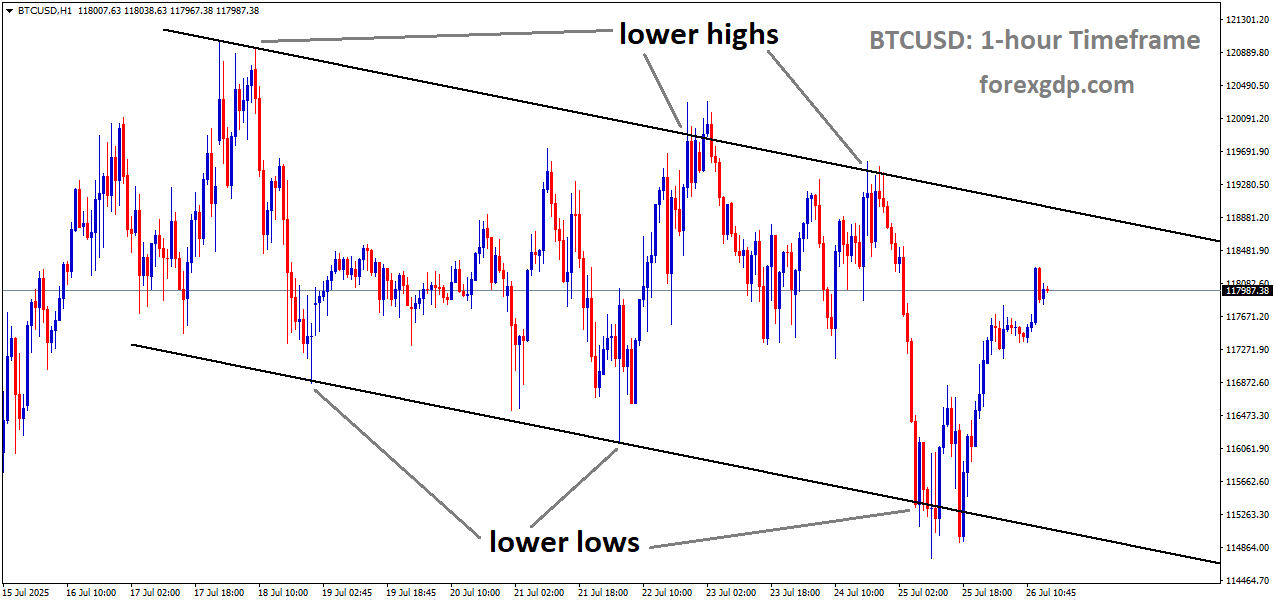
BTCUSD is moving in a descending channel
What’s Happening with Bitcoin ETFs?
Bitcoin Exchange Traded Funds (ETFs) have always been a strong indicator of institutional sentiment. When big players start investing or pulling back, the rest of the market tends to pay close attention. Recently, U.S.-listed Bitcoin spot ETFs showed the first signs of a slowdown after enjoying a steady streak of inflows for about six weeks straight.
Investor Sentiment Shifting?
According to recent data, these ETFs experienced a weekly outflow of nearly $58 million. While that might not sound massive compared to earlier surges, it’s still notable. It breaks the recent trend and hints that some investors might be stepping back a bit—possibly waiting for more clarity or stability before jumping back in.
This change doesn’t mean everyone is running for the exits. Instead, it could suggest a brief pause. Some investors might be locking in profits, while others are watching the broader financial landscape unfold before making their next move.
Why It Matters
When ETFs pull in a lot of money, it often signals growing confidence in Bitcoin as an asset. On the flip side, even a slight slowdown or outflow—like we’re seeing now—can mean hesitation. It’s like a group of people slowly stepping away from the table, curious to see what the next course looks like before digging in again.
Bitcoin Open Interest and What It Could Mean for Traders
Let’s talk about a term that pops up a lot in crypto discussions: open interest. It’s a fancy way of measuring how many futures contracts are currently active on exchanges. And right now, this number is climbing—big time.
Record-High Open Interest
Data shows that Bitcoin’s open interest hit a new all-time high of $44.5 billion. That’s a huge number. But here’s where it gets interesting: this surge in open interest is happening while Bitcoin’s price is nudging downward.

This combination—rising open interest and a falling price—often suggests that more traders are betting against Bitcoin. In simpler terms, short positions are increasing. Traders might be expecting the price to dip further, so they’re trying to profit from that decline.
Why You Should Pay Attention
This situation doesn’t automatically mean Bitcoin is doomed in the short term. But it does signal rising caution among traders. If a lot of people are shorting Bitcoin and something suddenly shifts—like a piece of positive news—those short positions could be forced to close quickly, triggering a sharp move in the opposite direction.
That kind of scenario is known in trading circles as a “short squeeze.” And when it happens, prices can spike fast. So while things might look bearish on the surface, the market is still full of potential twists and turns.
The Bigger Picture: Global Trade and Economic Developments
Now let’s zoom out for a second. Beyond the world of charts and trading desks, global events are always playing a role in shaping investor sentiment—and that includes Bitcoin.
U.S.-EU Trade Deal in the Works
There’s been chatter about a possible trade agreement between the U.S. and the European Union. While nothing is locked in yet, talks are heating up. Reports suggest that both sides are working toward a middle ground on tariffs and imports.
Even though the final details are still up in the air, the idea of strengthened trade ties between these two economic giants is generally seen as a good thing. It signals cooperation, and that kind of economic optimism can spill over into riskier assets like crypto.
New Agreements and Growing Confidence
Earlier in the week, a trade deal was also reached between the U.S. and Japan. That’s another positive signal. As global trade stabilizes and economies start aligning more closely, investor confidence usually gets a boost.
This uptick in confidence often flows into other markets, including Bitcoin. So even if crypto isn’t directly tied to trade policy, the ripple effects of improved global sentiment can make a difference.
So, Where Does That Leave Bitcoin Right Now?
To sum it all up, Bitcoin is currently in a bit of a reflective mood. The price is not soaring, but it’s not crashing either. ETFs are showing minor outflows, traders are opening new short positions, and global events are creating a mix of caution and optimism.
Here’s what this moment really looks like:
-
Cautious Optimism: Investors aren’t rushing in, but they’re not completely backing out either.
-
Shifting Strategies: Traders are adjusting positions, possibly bracing for a correction—or maybe just preparing for a sudden move.
-
Global Influence: Trade talks and economic news are acting like a slow-moving wave, gently pushing market moods in one direction or another.
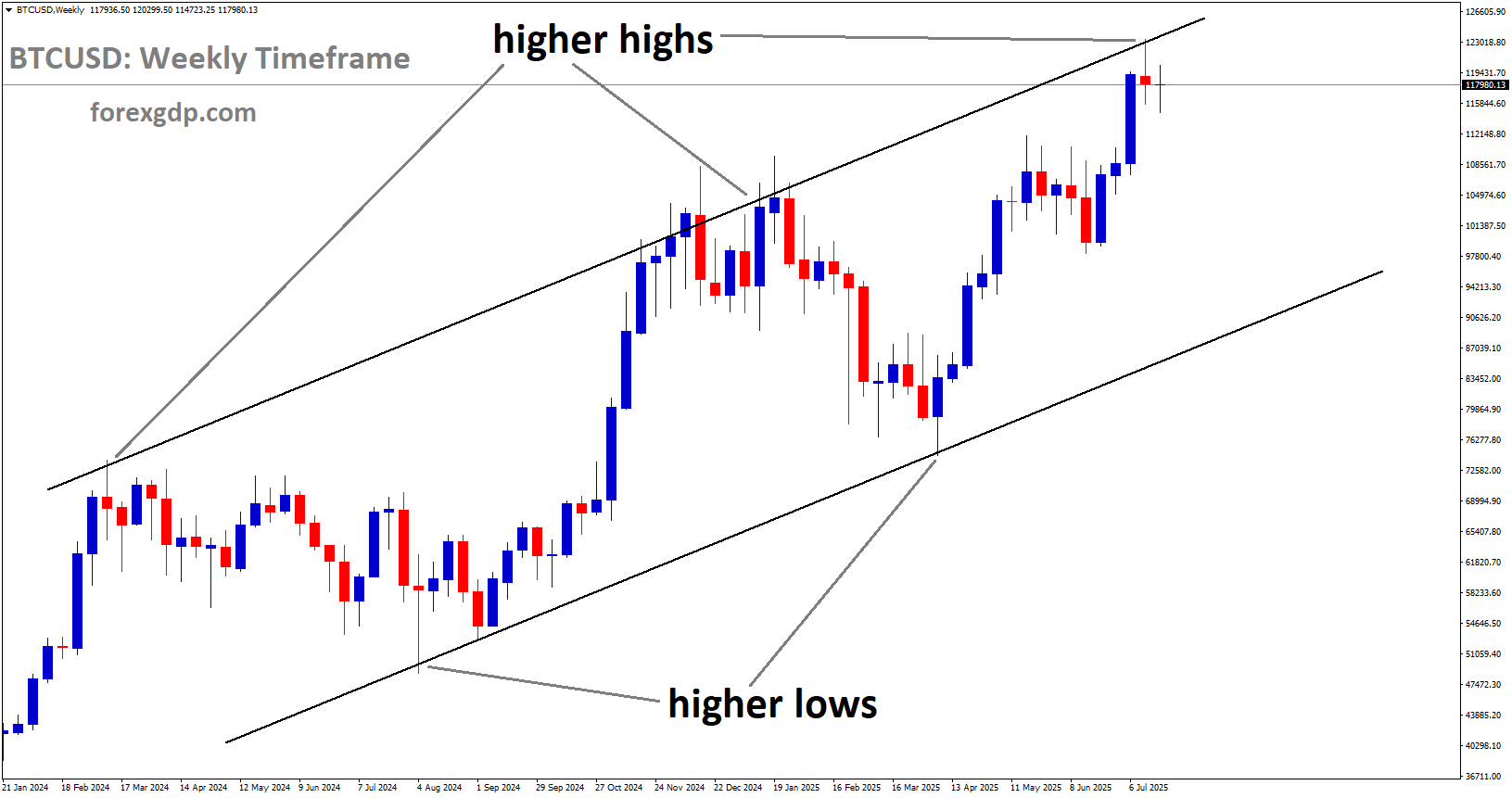
BTCUSD is moving in an Ascending channel, and the market has reached a higher high area of the channel
This kind of environment might not be filled with fireworks, but it’s important. It’s a reset phase. And in crypto, these quieter moments often set the stage for the next big shift—whether up or down.
Final Thoughts
Bitcoin isn’t just about the numbers on a screen—it’s about what those numbers represent. They show us how people are feeling, what they believe in, and how they’re reacting to the world around them. Right now, we’re in a period of cautious watching and waiting.
Whether you’re a long-term believer or a short-term trader, understanding these broader dynamics helps you stay grounded. Keep an eye on the trends, watch the news, and most importantly—stay informed. Because the next big move could be just around the corner.
Don’t trade all the time, trade forex only at the confirmed trade setups
Get more confirmed trade signals at premium or supreme – Click here to get more signals, 2200%, 800% growth in Real Live USD trading account of our users – click here to see , or If you want to get FREE Trial signals, You can Join FREE Signals Now!


